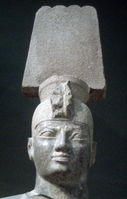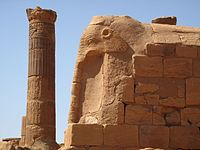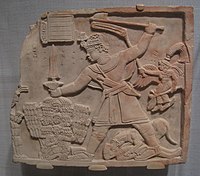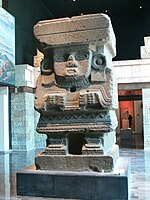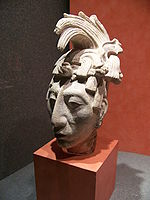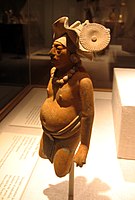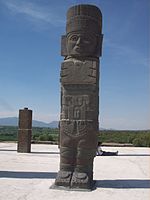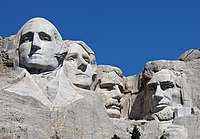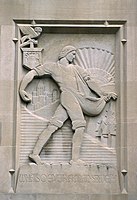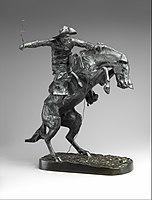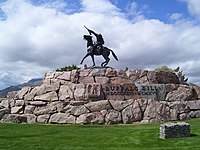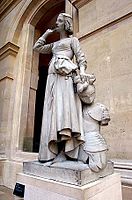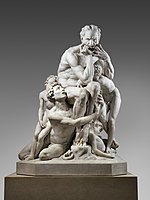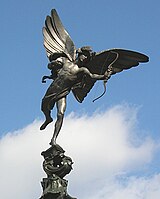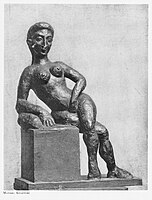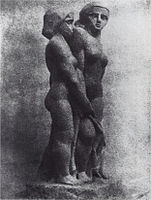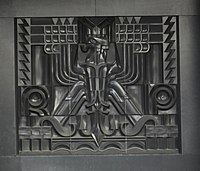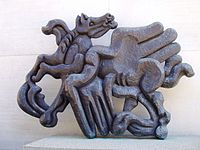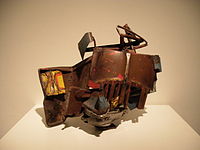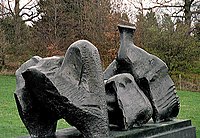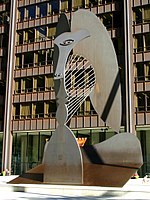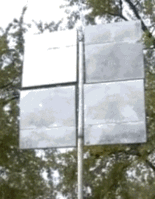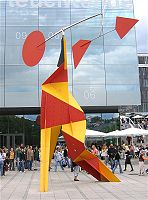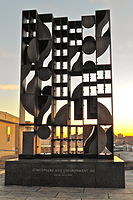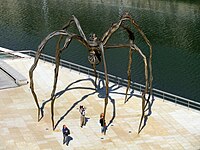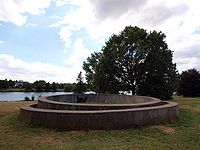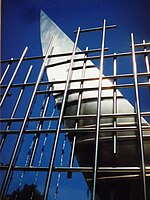Sculpture
This articlecontains too many pictures for its overall length.(April 2024) |
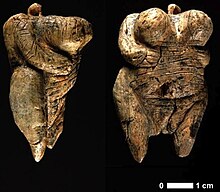

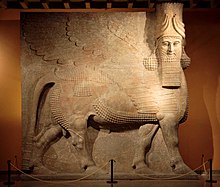
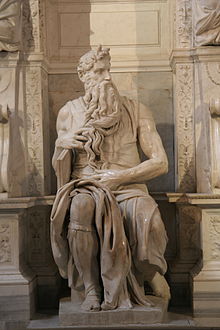
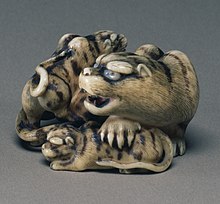
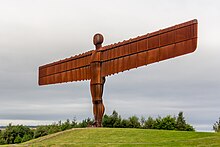
Sculptureis the branch of thevisual artsthat operates inthree dimensions.Sculpture is the three-dimensional art work which is physically presented in the dimensions of height, width and depth. It is one of theplastic arts.Durable sculptural processes originally usedcarving(the removal of material) and modelling (the addition of material, as clay), instone,metal,ceramics,woodand other materials but, sinceModernism,there has been almost complete freedom of materials and process. A wide variety of materials may be worked by removal such as carving, assembled byweldingor modelling, ormouldedorcast.
Sculpture in stone survives far better than works of art in perishable materials, and often represents the majority of the surviving works (other thanpottery) from ancient cultures, though conversely traditions of sculpture in wood may have vanished almost entirely. However, most ancient sculpture was brightly painted, and this has been lost.[2]
Sculpture has been central in religious devotion in many cultures, and until recent centuries, large sculptures, too expensive for private individuals to create, were usually an expression of religion or politics. Those cultures whose sculptures have survived in quantities include the cultures of the ancient Mediterranean, India and China, as well as many in Central and South America and Africa.
TheWesterntradition of sculpture began inancient Greece,and Greece is widely seen as producing great masterpieces in theclassicalperiod. During theMiddle Ages,Gothic sculpturerepresented the agonies and passions of the Christian faith. The revival of classical models in theRenaissanceproduced famous sculptures such asMichelangelo'sstatueofDavid.Modernist sculpture moved away from traditional processes and the emphasis on the depiction of the human body, with the making ofconstructed sculpture,and the presentation offound objectsas finished artworks.
Types
[edit]
A distinction exists between sculpture "in the round", free-standing sculpture such asstatues,not attached except possibly at the base to any other surface, and the various types ofrelief,which are at least partly attached to a background surface. Relief is often classified by the degree of projection from the wall into low orbas-relief,high relief,and sometimes an intermediatemid-relief.Sunk-reliefis a technique restricted toancient Egypt.Relief is the usual sculptural medium for large figure groups and narrative subjects, which are difficult to accomplish in the round, and is the typical technique used both forarchitectural sculpture,which is attached to buildings, and for small-scale sculpture decorating other objects, as in muchpottery,metalwork andjewellery.Relief sculpture may also decoratesteles,upright slabs, usually of stone, often also containing inscriptions.
Another basic distinction is between subtractive carving techniques, which remove material from an existing block or lump, for example of stone or wood, and modelling techniques which shape or build up the work from the material. Techniques such ascasting,stamping and moulding use an intermediate matrix containing the design to produce the work; many of these allow the production of several copies.
The term "sculpture" is often used mainly to describe large works, which are sometimes calledmonumental sculpture,meaning either or both of sculpture that is large, or that is attached to a building. But the term properly covers many types of small works in three dimensions using the same techniques, including coins andmedals,hardstone carvings,a term for small carvings in stone that can take detailed work.
The very large or "colossal" statue has had an enduring appeal sinceantiquity;thelargest on recordat 182 m (597 ft) is the 2018 IndianStatue of Unity.Another grand form of portrait sculpture is theequestrian statueof a rider on horse, which has become rare in recent decades. The smallest forms of life-size portrait sculpture are the "head", showing just that, or thebust,a representation of a person from the chest up. Small forms of sculpture include thefigurine,normally a statue that is no more than 18 inches (46 cm) tall, and for reliefs theplaquette,medal or coin.
Modern and contemporary art have added a number of non-traditional forms of sculpture, includingsound sculpture,light sculpture,environmental art,environmental sculpture,street art sculpture,kinetic sculpture(involving aspects ofphysical motion),land art,andsite-specific art.Sculpture is an important form ofpublic art.A collection of sculpture in a garden setting can be called asculpture garden.There is also a view that buildings are a type of sculpture, withConstantin Brâncușidescribing architecture as "inhabited sculpture".[citation needed]
Purposes and subjects
[edit]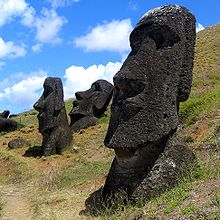
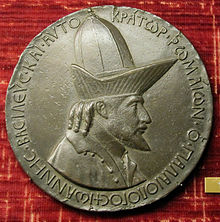
One of the most common purposes of sculpture is in some form of association with religion.Cult imagesare common in many cultures, though they are often not the colossal statues of deities which characterizedancient Greek art,like theStatue of Zeus at Olympia.The actual cult images in the innermost sanctuaries ofEgyptian temples,of which none have survived, were evidently rather small, even in the largest temples. The same is often true inHinduism,where the very simple and ancient form of thelingamis the most common.Buddhismbrought the sculpture of religious figures to East Asia, where there seems to have been no earlier equivalent tradition, though again simple shapes like thebiandcongprobably had religious significance.
Small sculptures as personal possessions go back to the earliest prehistoric art, and the use of very large sculpture aspublic art,especially to impress the viewer with the power of a ruler, goes back at least to theGreat Sphinxof some 4,500 years ago. Inarchaeologyand art history the appearance, and sometimes disappearance, of large or monumental sculpture in a culture is regarded as of great significance, though tracing the emergence is often complicated by the presumed existence of sculpture in wood and other perishable materials of which no record remains;[3]
Thetotem poleis an example of a tradition of monumental sculpture in wood that would leave no traces for archaeology. The ability to summon the resources to create monumental sculpture, by transporting usually very heavy materials and arranging for the payment of what are usually regarded as full-time sculptors, is considered a mark of a relatively advanced culture in terms of social organization. Recent unexpected discoveries of ancient ChineseBronze Agefigures atSanxingdui,some more than twice human size, have disturbed many ideas held about early Chinese civilization, since only much smaller bronzes were previously known.[4]
Some undoubtedly advanced cultures, such as theIndus Valley civilization,appear to have had no monumental sculpture at all, though producing very sophisticated figurines and seals. TheMississippian cultureseems to have been progressing towards its use, with small stone figures, when it collapsed. Other cultures, such as ancient Egypt and theEaster Island culture,seem to have devoted enormous resources to very large-scale monumental sculpture from a very early stage.
The collecting of sculpture, including that of earlier periods, goes back some 2,000 years in Greece, China and Mesoamerica, and many collections were available on semi-public display long before the modernmuseumwas invented. From the 20th century the relatively restricted range of subjects found in large sculpture expanded greatly, with abstract subjects and the use or representation of any type of subject now common. Today much sculpture is made for intermittent display in galleries and museums, and the ability to transport and store the increasingly large works is a factor in their construction.
Small decorativefigurines,most often in ceramics, are as popular today (though strangely neglected bymodernandContemporary art) as they were in theRococo,or in ancient Greece whenTanagra figurineswere a major industry, or in East Asian andPre-Columbian art.Small sculpted fittings for furniture and other objects go well back into antiquity, as in theNimrud ivories,Begram ivoriesand finds from the tomb ofTutankhamun.
Portrait sculpture began inEgypt,where theNarmer Paletteshows a ruler of the 32nd century BCE, andMesopotamia,where we have 27 survivingstatues of Gudea,who ruledLagashc. 2144–2124 BCE. In ancient Greece and Rome, the erection of a portrait statue in a public place was almost the highest mark of honour, and the ambition of the elite, who might also be depicted on a coin.[5]
In other cultures such as Egypt and the Near East public statues were almost exclusively the preserve of the ruler, with other wealthy people only being portrayed in their tombs. Rulers are typically the only people given portraits in Pre-Columbian cultures, beginning with theOlmec colossal headsof about 3,000 years ago. East Asian portrait sculpture was entirely religious, with leading clergy being commemorated with statues, especially the founders of monasteries, but not rulers, or ancestors. The Mediterranean tradition revived, initially only for tomb effigies and coins, in the Middle Ages, but expanded greatly in the Renaissance, which invented new forms such as the personal portraitmedal.
Animals are, with the human figure, the earliest subject for sculpture, and have always been popular, sometimes realistic, but often imaginary monsters; in China animals and monsters are almost the only traditional subjects for stone sculpture outside tombs and temples. The kingdom of plants is important only in jewellery and decorative reliefs, but these form almost all the large sculpture ofByzantine artandIslamic art,and are very important in most Eurasian traditions, where motifs such as thepalmetteand vine scroll have passed east and west for over two millennia.
One form of sculpture found in many prehistoric cultures around the world is specially enlarged versions of ordinary tools, weapons or vessels created in impractical precious materials, for either some form of ceremonial use or display or as offerings.Jadeor other types ofgreenstonewere used in China,OlmecMexico, andNeolithic Europe,and in early Mesopotamia large pottery shapes were produced in stone. Bronze was used in Europe and China for large axes and blades, like theOxborough Dirk.
Materials and techniques
[edit]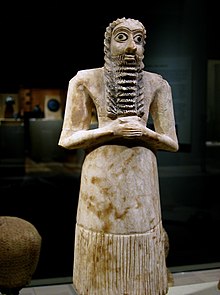
The materials used in sculpture are diverse, changing throughout history. The classic materials, with outstanding durability, are metal, especiallybronze,stone and pottery, with wood, bone andantlerless durable but cheaper options. Precious materials such asgold,silver,jade,andivoryare often used for small luxury works, and sometimes in larger ones, as inchryselephantinestatues. More common and less expensive materials were used for sculpture for wider consumption, includinghardwoods(such asoak,box/boxwood,andlime/linden);terracottaand otherceramics,wax (a very common material for models for casting, and receiving the impressions ofcylinder sealsand engraved gems), and cast metals such aspewterandzinc(spelter). But a vast number of other materials have been used as part of sculptures, in ethnographic and ancient works as much as modern ones.
Sculptures are oftenpainted,but commonly lose their paint to time, or restorers. Many different painting techniques have been used in making sculpture, includingtempera,oil painting,gilding,house paint, aerosol, enamel and sandblasting.[2][6]
Many sculptors seek new ways and materials to make art. One ofPablo Picasso's most famous sculptures includedbicycleparts.Alexander Calderand other modernists made spectacular use of paintedsteel.Since the 1960s,acrylicsand other plastics have been used as well.Andy Goldsworthymakes his unusually ephemeral sculptures from almost entirely natural materials in natural settings. Some sculpture, such asice sculpture,sand sculpture,andgas sculpture,is deliberately short-lived. Recent sculptors have usedstained glass,tools, machine parts, hardware and consumer packaging to fashion their works. Sculptors sometimes usefound objects,andChinese scholar's rockshave been appreciated for many centuries.
Stone
[edit]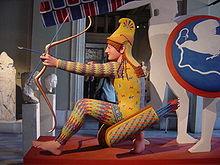
Stone sculptureis an ancient activity where pieces of rough naturalstoneare shaped by thecontrolled removal of stone.Owing to the permanence of the material, evidence can be found that even the earliest societies indulged in some form of stone work, though not all areas of the world have such abundance of good stone for carving as Egypt, Greece, India and most of Europe.Petroglyphs(also called rock engravings) are perhaps the earliest form: images created by removing part of a rock surface which remainsin situ,by incising, pecking, carving, and abrading.Monumental sculpturecovers large works, andarchitectural sculpture,which is attached to buildings.Hardstone carvingis the carving for artistic purposes ofsemi-preciousstones such asjade,agate,onyx,rock crystal,sardorcarnelian,and a general term for an object made in this way.Alabasteror mineralgypsumis a soft mineral that is easy to carve for smaller works and still relatively durable.Engraved gemsare small carved gems, includingcameos,originally used asseal rings.
The copying of an original statue in stone, which was very important for ancient Greek statues, which are nearly all known from copies, was traditionally achieved by "pointing",along with more freehand methods. Pointing involved setting up a grid of string squares on a wooden frame surrounding the original, and then measuring the position on the grid and the distance between grid and statue of a series of individual points, and then using this information to carve into the block from which the copy is made.[8]
Metal
[edit]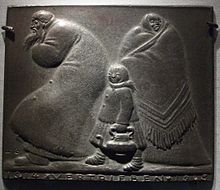
Bronzeand relatedcopper alloysare the oldest and still the most popular metals forcastmetal sculptures; a castbronze sculptureis often called simply a "bronze". Common bronze alloys have the unusual and desirable property of expanding slightly just before they set, thus filling the finest details of a mould. Their strength and lack of brittleness (ductility) is an advantage when figures in action are to be created, especially when compared to variousceramicor stone materials (seemarble sculpturefor several examples).Goldis the softest and most precious metal, and very important injewellery;withsilverit is soft enough to be worked with hammers and other tools as well as cast;repoussé and chasingare among the techniques used in gold andsilversmithing.
Castingis a group of manufacturing processes by which a liquid material (bronze, copper, glass, aluminum, iron) is (usually) poured into a mould, which contains a hollow cavity of the desired shape, and then allowed to solidify. The solid casting is then ejected or broken out to complete the process,[9]although a final stage of "cold work" may follow on the finished cast. Casting may be used to form hot liquid metals or various materials thatcold setafter mixing of components (such asepoxies,concrete,plasterandclay). Casting is most often used for making complex shapes that would be otherwise difficult or uneconomical to make by other methods. The oldest surviving casting is a copper Mesopotamian frog from 3200 BCE.[10]Specific techniques includelost-wax casting,plaster mould casting, andsand casting.
Weldingis a process where different pieces of metal are fused together to create different shapes and designs. There are many different forms of welding, such asOxy-fuel welding,Stick welding,MIG welding,andTIG welding.Oxy-fuel is probably the most common method of welding when it comes to creating steel sculptures because it is the easiest to use for shaping the steel as well as making clean and less noticeable joins of the steel. The key to Oxy-fuel welding is heating each piece of metal to be joined evenly until all are red and have a shine to them. Once that shine is on each piece, that shine will soon become a 'pool' where the metal is liquified and the welder must get the pools to join, fusing the metal. Once cooled off, the location where the pools joined are now one continuous piece of metal. Also used heavily in Oxy-fuel sculpture creation is forging.Forgingis the process of heating metal to a certain point to soften it enough to be shaped into different forms. One very common example is heating the end of a steel rod and hitting the red heated tip with a hammer while on an anvil to form a point. In between hammer swings, the forger rotates the rod and gradually forms a sharpened point from the blunt end of a steel rod.
Glass
[edit]

Glassmay be used for sculpture through a wide range of working techniques, though the use of it for large works is a recent development. It can be carved, though with considerable difficulty; the RomanLycurgus Cupis all but unique.[11]There are various ways ofmoulding glass:hot casting can be done by ladling molten glass into moulds that have been created by pressing shapes into sand, carved graphite or detailed plaster/silica moulds. Kiln casting glass involves heating chunks of glass in a kiln until they are liquid and flow into a waiting mould below it in the kiln. Hot glass can alsobe blownand/or hot sculpted with hand tools either as a solid mass or as part of a blown object. More recent techniques involve chiseling and bonding plate glass with polymer silicates and UV light.[12]
Pottery
[edit]Pottery is one of the oldest materials for sculpture, as well as clay being the medium in which many sculptures cast in metal are originally modelled for casting. Sculptors often build small preliminary works calledmaquettesof ephemeral materials such asplaster of Paris,wax, unfired clay, orplasticine.[13]Many cultures have produced pottery which combines a function as a vessel with a sculptural form, and smallfigurineshave often been as popular as they are in modern Western culture. Stamps and moulds were used by most ancient civilizations, fromancient Romeand Mesopotamia to China.[14]
Wood carving
[edit]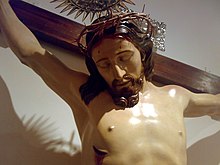
Wood carvinghas been extremely widely practiced, but survives much less well than the other main materials, being vulnerable to decay, insect damage, and fire. It therefore forms an important hidden element in the art history of many cultures.[3]Outdoor wood sculpture does not last long in most parts of the world, so that we have little idea how thetotem poletradition developed. Many of the most important sculptures of China and Japan in particular are in wood, and the great majority ofAfrican sculptureand that ofOceaniaand other regions.
Wood is light, so suitable for masks and other sculpture intended to be carried, and can take very fine detail. It is also much easier to work than stone. It has been very often painted after carving, but the paint wears less well than the wood, and is often missing in surviving pieces. Painted wood is often technically described as "wood andpolychrome".Typically a layer ofgessoor plaster is applied to the wood, and then the paint is applied to that.
Soft materials
[edit]Three dimensional work incorporating unconventional materials such as cloth, fur, plastics, rubber and nylon, that can thus be stuffed, sewn, hung, draped or woven, are known assoft sculptures.Well known creators of soft sculptures includeClaes Oldenburg,Yayoi Kusama,Eva Hesse,Sarah LucasandMagdalena Abakanowicz.[15]
Social status of sculptors
[edit]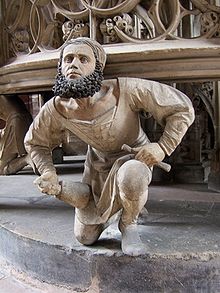
Worldwide, sculptors have usually been tradespeople whose work is unsigned; in some traditions, for example China, where sculpture did not share the prestige ofliterati painting,this has affected the status of sculpture itself.[16]Even inancient Greece,where sculptors such asPhidiasbecame famous, they appear to have retained much the same social status as other artisans, and perhaps not much greater financial rewards, although some signed their works.[17]In theMiddle Agesartists such as the 12th-centuryGislebertussometimes signed their work, and were sought after by different cities, especially from theTrecentoonwards in Italy, with figures such asArnolfo di Cambio,andNicola Pisanoand his sonGiovanni.Goldsmiths and jewellers, dealing with precious materials and often doubling as bankers, belonged to powerfulguildsand had considerable status, often holding civic office. Many sculptors also practised in other arts;Andrea del Verrocchioalso painted, andGiovanni Pisano,Michelangelo, andJacopo Sansovinowerearchitects.Some sculptors maintained large workshops. Even in the Renaissance the physical nature of the work was perceived by Leonardo da Vinci and others as pulling down the status of sculpture in the arts, though the reputation of Michelangelo perhaps put this long-held idea to rest.
From theHigh Renaissanceartists such as Michelangelo,Leone LeoniandGiambolognacould become wealthy, and ennobled, and enter the circle of princes, after a period of sharp argument over the relative status of sculpture and painting.[18]Much decorative sculpture on buildings remained a trade, but sculptors producing individual pieces were recognised on a level with painters. From the 18th century or earlier sculpture also attracted middle-class students, although it was slower to do so than painting. Women sculptors took longer to appear than women painters, and were less prominent until the 20th century.
Anti-sculpture movements
[edit]Aniconismoriginated withJudaism,which did not accept figurative sculpture until the 19th century,[19]before expanding toChristianity,which initially accepted large sculptures. In Christianity and Buddhism, sculpture became very significant. ChristianEastern Orthodoxyhas never accepted monumental sculpture, andIslamhas consistently rejected nearly all figurative sculpture, except for very small figures in reliefs and some animal figures that fulfill a useful function, like the famous lions supporting a fountain in theAlhambra.Many forms ofProtestantismalso do not approve of religious sculpture. There has been muchiconoclasmof sculpture for religious motives, from the Early Christians and theBeeldenstormof theProtestant Reformationto the 2001 destruction of theBuddhas of Bamyanby theTaliban.
History
[edit]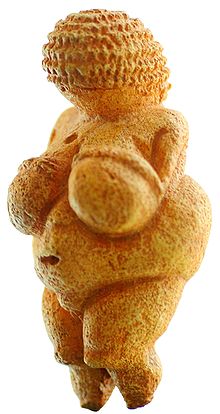
Prehistoric periods
[edit]Europe
[edit]The earliest undisputed examples of sculpture belong to theAurignacian culture,which was located in Europe and southwest Asia and active at the beginning of theUpper Paleolithic.As well as producing some of the earliest knowncave art,the people of this culture developed finely-crafted stone tools, manufacturing pendants, bracelets, ivory beads, and bone-flutes, as well as three-dimensional figurines.[20][21]
The 30 cm tallLöwenmenschfound in the Hohlenstein Stadel area of Germany is ananthropomorphiclion-human figure carved fromwoolly mammothivory. It has been dated to about 35–40,000BP, making it, along with theVenus of Hohle Fels,the oldest known uncontested examples of sculpture.[22]
Much survivingprehistoric artis small portable sculptures, with a small group of femaleVenus figurinessuch as theVenus of Willendorf(24–26,000BP) found across central Europe.[23]TheSwimming Reindeerof about 13,000 years ago is one of the finest of a number ofMagdaleniancarvings in bone or antler of animals in theart of the Upper Paleolithic,although they are outnumbered by engraved pieces, which are sometimes classified as sculpture.[24]Two of the largest prehistoric sculptures can be found at theTuc d'Audobert cavesin France, where around 12–17,000 years ago a masterful sculptor used a spatula-like stone tool and fingers to model a pair of large bison in clay against a limestone rock.[25]
With the beginning of theMesolithicin Europe figurative sculpture greatly reduced,[26]and remained a less common element in art than relief decoration of practical objects until the Roman period, despite some works such as theGundestrup cauldronfrom theEuropean Iron Ageand the Bronze AgeTrundholm sun chariot.[27]
Ancient Near East
[edit]From theancient Near East,the over-life sized stoneUrfa Manfrom modernTurkeycomes from about 9,000 BCE, and the'Ain Ghazal Statuesfrom around 7200 and 6500 BCE. These are from modernJordan,made of lime plaster and reeds, and about half life-size; there are 15 statues, some with two heads side by side, and 15 busts. Small clay figures of people and animals are found at many sites across the Near East from thePre-Pottery Neolithic,and represent the start of a more-or-less continuous tradition in the region.
-
Löwenmensch,fromHohlenstein-Stadel,now in Ulmer Museum,Ulm,Germany,the oldest knownanthropomorphicanimal-human statuette,Aurignacianera, c.35–40,000BP
-
Adorant from the Geißenklösterle cave,Germany,c.35–40,000BP
-
Wild horsefrom the Vogelherd cave,Germany,c.33–35,000BP
-
Venus of Lausselc.27,000BP, an Upper Palaeolithic carving, Bordeaux museum, France
-
Creeping Hyena,c.12–17,000BP,mammoth ivory,found inLa Madeleine,France
-
Swimming Reindeerc.13,000 BP, female and male swimming reindeer – lateMagdalenianperiod, found at Montastruc, Tarn et Garonne, France
-
TheTrundholm sun chariot,perhaps 1800–1500 BCE; this side isgilded,the other is "dark".
Ancient Near East
[edit]
TheProtoliterate periodinMesopotamia,dominated byUruk,saw the production of sophisticated works like theWarka Vaseandcylinder seals.TheGuennol Lionessis an outstanding smalllimestonefigure fromElamof about 3000–2800 BCE, part human and part lioness.[28]A little later there are a number of figures of large-eyed priests and worshippers, mostly in alabaster and up to a foot high, who attended templecult imagesof the deity, but very few of these have survived.[29]Sculptures from theSumerianandAkkadianperiod generally had large, staring eyes, and long beards on the men. Many masterpieces have also been found at the Royal Cemetery atUr(c. 2650 BCE), including the two figures of aRam in a Thicket,theCopper Bulland a bull's head on one of theLyres of Ur.[30]
From the many subsequent periods before the ascendency of theNeo-Assyrian Empirein the 10th century BCE, Mesopotamian art survives in a number of forms:cylinder seals,relatively small figures in the round, and reliefs of various sizes, including cheap plaques of moulded pottery for the home, some religious and some apparently not.[31]TheBurney Reliefis an unusually elaborate and relatively large (20 x 15 inches, 50 x 37 cm)terracottaplaque of a naked winged goddess with the feet of a bird of prey, and attendant owls and lions. It comes from the 18th or 19th century BCE, and may also be moulded.[32]Stonestelae,votive offerings,or ones probably commemorating victories and showing feasts, are also found from temples, which unlike more official ones lack inscriptions that would explain them;[33]the fragmentaryStele of the Vulturesis an early example of the inscribed type,[34]and the AssyrianBlack Obelisk of Shalmaneser IIIa large and solid late one.[35]
The conquest of the whole of Mesopotamia and much surrounding territory by the Assyrians created a larger and wealthier state than the region had known before, and very grandiose art in palaces and public places, no doubt partly intended to match the splendour of the art of the neighbouring Egyptian empire. Unlike earlier states, the Assyrians could use easily carved stone from northern Iraq, and did so in great quantity. The Assyrians developed a style of extremelylarge schemes of very finely detailed narrative low reliefsin stone for palaces, with scenes of war or hunting; theBritish Museumhas an outstanding collection, including theLion Hunt of Ashurbanipaland theLachish reliefsshowing a campaign. They produced very little sculpture in the round, except for colossal guardian figures of the human-headedlamassu,which are sculpted in high relief on two sides of a rectangular block, with the heads effectively in the round (and also five legs, so that both views seem complete). Even before dominating the region they had continued the cylinder seal tradition with designs which are often exceptionally energetic and refined.[36]
-
TheGuennol Lioness,3rd millennium BCE, 3.25 inches (8.3 cm) high
-
One of 18Statues of Gudea,a ruler around 2090 BCE
-
TheBurney Relief,Old Babylonian,around 1800 BCE
-
Part of theLion Hunt of Ashurbanipal,c. 640 BCE,Nineveh
Ancient Egypt
[edit]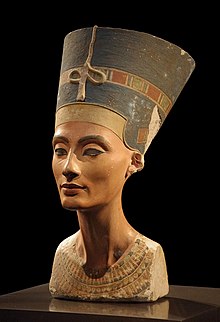
Themonumental sculptureof ancient Egypt is world-famous, but refined and delicate small works exist in much greater numbers. The Egyptians used the distinctive technique ofsunk relief,which is well suited to very bright sunlight. The main figures in reliefs adhere to the same figure convention as in painting, with parted legs (where not seated) and head shown from the side, but the torso from the front, and a standard set of proportions making up the figure, using 18 "fists" to go from the ground to the hair-line on the forehead.[37]This appears as early as theNarmer Palettefrom Dynasty I. However, there as elsewhere the convention is not used for minor figures shown engaged in some activity, such as the captives and corpses.[38]Other conventions make statues of males darker than females ones. Very conventionalized portrait statues appear from as early as Dynasty II, before 2,780 BCE,[39]and with the exception of theart of the Amarna periodofAhkenaten,[40]and some other periods such as Dynasty XII, the idealized features of rulers, like other Egyptian artistic conventions, changed little until after the Greek conquest.[41]
Egyptianpharaohswere always regarded as deities, but other deities are much less common in large statues, except when they represent the pharaohasanother deity; however the other deities are frequently shown in paintings and reliefs. The famous row of four colossal statues outside themain temple at Abu Simbeleach showRameses II,a typical scheme, though here exceptionally large.[42]Small figures of deities, or their animal personifications, are very common, and found in popular materials such as pottery. Most larger sculpture survives fromEgyptian templesor tombs; by Dynasty IV (2680–2565 BCE) at the latest the idea of theKa statuewas firmly established. These were put in tombs as a resting place for thekaportion of the soul,and so we have a good number of less conventionalized statues of well-off administrators and their wives, many in wood as Egypt is one of the few places in the world where the climate allows wood to survive over millennia. The so-calledreserve heads,plain hairless heads, are especially naturalistic. Early tombs also contained small models of the slaves, animals, buildings and objects such as boats necessary for the deceased to continue his lifestyle in the afterworld, and laterUshabtifigures.[43]
-
Facsimileof theNarmer Palette,c. 3100 BCE, which already shows the canonical Egyptian profile view and proportions of the figure
-
Menkaura(Mycerinus) and queen, Old Kingdom, Dynasty 4, 2490–2472 BCE. The formality of the pose is reduced by the queen's arm round her husband
-
Wooden tomb models, Dynasty XI; a high administrator counts his cattle
-
Osirison alapis lazulipillar in the middle, flanked byHoruson the left, andIsison the right, 22nd dynasty,Louvre
-
Theka statueprovided a physical place for the ka to manifest.Egyptian Museum, Cairo
-
Block statueof Pa-Ankh-Ra, ship master, bearing a statue ofPtah.Late Period,c. 650–633 BCE, Cabinet des Médailles
Europe
[edit]Ancient Greece
[edit]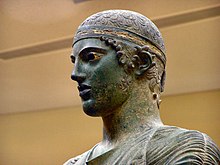
The first distinctive style ofancient Greek sculpturedeveloped in the Early Bronze AgeCycladicperiod (3rd millennium BCE), where marble figures, usually female and small, are represented in an elegantly simplified geometrical style. Most typical is a standing pose with arms crossed in front, but other figures are shown in different poses, including a complicated figure of a harpist seated on a chair.[44]
The subsequentMinoanandMycenaeancultures developed sculpture further, under influence from Syria and elsewhere, but it is in the laterArchaic periodfrom around 650 BCE that thekourosdeveloped. These are large standing statues of naked youths, found in temples and tombs, with thekoreas the clothed female equivalent, with elaborately dressed hair; both have the "archaic smile".They seem to have served a number of functions, perhaps sometimes representing deities and sometimes the person buried in a grave, as with theKroisos Kouros.They are clearly influenced by Egyptian and Syrian styles, but the Greek artists were much more ready to experiment within the style.
During the 6th century Greek sculpture developed rapidly, becoming more naturalistic, and with much more active and varied figure poses in narrative scenes, though still within idealized conventions. Sculpturedpedimentswere added totemples,including theParthenonin Athens, where the remains of the pediment of around 520 using figures in the round were fortunately used as infill for new buildings after the Persian sack in 480 BCE, and recovered from the 1880s on in fresh unweathered condition. Other significant remains of architectural sculpture come fromPaestumin Italy,Corfu,Delphiand theTemple of AphaeainAegina(much now inMunich).[45]Most Greek sculpture originally included at least some colour; theNy Carlsberg Glyptotek Museumin Copenhagen, Denmark, has done extensive research and recreation of the original colours.[46][47]
-
Cycladic statue 2700–2300 BCE. Head from the figure of a woman, H. 27 centimetres (11 in)
-
Cycladic Female Figurine,c. 2500–2400 BCE,41.5 cm (16.3 in) high
-
Mycenae, 1600−1500 BCE. Silver rhyton with gold horns and rosette on the forehead
-
Late Archaic warrior from the east pediment of theTemple of Aphaea,c. 500
-
TheAmathus sarcophagus,fromAmathus,Cyprus,2nd quarter of the 5th century BCEArchaic period,Metropolitan Museum of Art
Classical
[edit]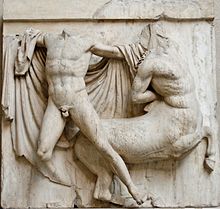
There are fewer original remains from the first phase of the Classical period, often called theSevere style;free-standing statues were now mostly made in bronze, which always had value as scrap. The Severe style lasted from around 500 in reliefs, and soon after 480 in statues, to about 450. The relatively rigid poses of figures relaxed, and asymmetrical turning positions and oblique views became common, and deliberately sought. This was combined with a better understanding of anatomy and the harmonious structure of sculpted figures, and the pursuit of naturalistic representation as an aim, which had not been present before. Excavations at theTemple of Zeus, Olympiasince 1829 have revealed the largest group of remains, from about 460, of which many are in theLouvre.[48]
The "High Classical" period lasted only a few decades from about 450 to 400, but has had a momentous influence on art, and retains a special prestige, despite a very restricted number of original survivals. The best known works are theParthenon Marbles,traditionally (sincePlutarch) executed by a team led by the most famous ancient Greek sculptorPhidias,active from about 465–425, who was in his own day more famous for his colossalchryselephantineStatue of Zeus at Olympia(c. 432), one of theSeven Wonders of the Ancient World,hisAthena Parthenos(438), the cult image of theParthenon,andAthena Promachos,a colossal bronze figure that stood next to the Parthenon; all of these are lost but are known from many representations. He is also credited as the creator of some life-size bronze statues known only from later copies whose identification is controversial, including theLudovisi Hermes.[49]
The High Classical style continued to develop realism and sophistication in the human figure, and improved the depiction of drapery (clothes), using it to add to the impact of active poses. Facial expressions were usually very restrained, even in combat scenes. The composition of groups of figures in reliefs and on pediments combined complexity and harmony in a way that had a permanent influence on Western art. Relief could be very high indeed, as in the Parthenon illustration below, where most of the leg of the warrior is completely detached from the background, as were the missing parts; relief this high made sculptures more subject to damage.[50]The Late Classical style developed the free-standing female nude statue, supposedly an innovation ofPraxiteles,and developed increasingly complex and subtle poses that were interesting when viewed from a number of angles, as well as more expressive faces; both trends were to be taken much further in the Hellenistic period.[51]
Hellenistic
[edit]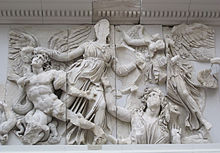

TheHellenistic periodis conventionally dated from the death ofAlexander the Greatin 323 BCE, and ending either with the final conquest of the Greek heartlands byRomein 146 BCE or with the final defeat of the last remaining successor-state to Alexander's empire after theBattle of Actiumin 31 BCE, which also marks the end ofRepublican Rome.[52]It is thus much longer than the previous periods, and includes at least two major phases: a "Pergamene" style of experimentation, exuberance and some sentimentality and vulgarity, and in the 2nd century BCE a classicising return to a more austere simplicity and elegance; beyond such generalizations dating is typically very uncertain, especially when only later copies are known, as is usually the case. The initial Pergamene style was not especially associated withPergamon,from which it takes its name, but the very wealthy kings of that state were among the first to collect and also copy Classical sculpture, and also commissioned much new work, including the famousPergamon Altarwhose sculpture is now mostly in Berlin and which exemplifies the new style, as do theMausoleum at Halicarnassus(another of the Seven Wonders), the famousLaocoön and his Sonsin theVatican Museums,a late example, and the bronze original ofThe Dying Gaul(illustrated at top), which we know was part of a group actually commissioned for Pergamon in about 228 BCE, from which theLudovisi Gaulwas also a copy. The group called theFarnese Bull,possibly a 2nd-century marble original, is still larger and more complex,[53]
Hellenistic sculpture greatly expanded the range of subjects represented, partly as a result of greater general prosperity, and the emergence of a very wealthy class who had large houses decorated with sculpture, although we know that some examples of subjects that seem best suited to the home, such as children with animals, were in fact placed in temples or other public places. For a much more popular home decoration market there wereTanagra figurines,and those from other centres where small pottery figures were produced on an industrial scale, some religious but others showing animals and elegantly dressed ladies. Sculptors became more technically skilled in representing facial expressions conveying a wide variety of emotions and the portraiture of individuals, as well representing different ages and races. The reliefs from the Mausoleum are rather atypical in that respect; most work was free-standing, and group compositions with several figures to be seen in the round, like theLaocoonand the Pergamon group celebrating victory over the Gauls became popular, having been rare before. TheBarberini Faun,showing asatyrsprawled asleep, presumably after drink, is an example of the moral relaxation of the period, and the readiness to create large and expensive sculptures of subjects that fall short of the heroic.[54]
After the conquests of AlexanderHellenistic culturewas dominant in the courts of most of the Near East, and some ofCentral Asia,and increasingly being adopted by European elites, especially in Italy, whereGreek coloniesinitially controlled most of the South. Hellenistic art, and artists, spread very widely, and was especially influential in the expanding Roman Republic and when it encountered Buddhism in the easternmost extensions of the Hellenistic area. The massive so-calledAlexander Sarcophagusfound inSidonin modern Lebanon, was probably made there at the start of the period by expatriate Greek artists for a Hellenized Persian governor.[55]The wealth of the period led to a greatly increased production of luxury forms of small sculpture, includingengraved gemsand cameos, jewellery, and gold and silverware.
-
TheRiace Bronzes,very rare bronze figures recovered from the sea, c. 460–430
-
Hermes and the Infant Dionysos,possibly an original byPraxiteles,4th century
-
Two elegant ladies, pottery figurines, 350–300
-
Bronze Statuette of a Horse,late 2nd – 1st century BCEMetropolitan Museum of Art
-
Laocoön and his Sons,Greek, (LateHellenistic), perhaps a copy, between 200 BCE and 20 CE,white marble,Vatican Museum
-
Leochares,Apollo Belvedere,c. 130–140 CE. Roman copy after a Greek bronze original of 330–320 BCE. Vatican Museums
Europe after the Greeks
[edit]Roman sculpture
[edit]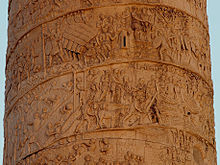

Early Roman art was influenced by the art of Greece and that of the neighbouringEtruscans,themselves greatly influenced by their Greek trading partners. An Etruscan speciality was near life size tomb effigies interracotta,usually lying on top of asarcophaguslid propped up on one elbow in the pose of a diner in that period. As the expandingRoman Republicbegan to conquer Greek territory, at first in Southern Italy and then the entire Hellenistic world except for theParthianfar east, official andpatriciansculpture became largely an extension of the Hellenistic style, from which specifically Roman elements are hard to disentangle, especially as so much Greek sculpture survives only in copies of the Roman period.[56]By the 2nd century BCE, "most of the sculptors working at Rome" were Greek,[57]often enslaved in conquests such as that ofCorinth(146 BCE), and sculptors continued to be mostly Greeks, often slaves, whose names are very rarely recorded. Vast numbers of Greek statues were imported to Rome, whether as booty or the result of extortion or commerce, and temples were often decorated with re-used Greek works.[58]
A native Italian style can be seen in the tomb monuments, which very often featured portrait busts, of prosperous middle-class Romans, andportraitureis arguably the main strength of Roman sculpture. There are no survivals from the tradition of masks of ancestors that were worn in processions at the funerals of the great families and otherwise displayed in the home, but many of the busts that survive must represent ancestral figures, perhaps from the large family tombs like theTomb of the Scipiosor the later mausolea outside the city. The famous bronze head supposedly ofLucius Junius Brutusis very variously dated, but taken as a very rare survival of Italic style under the Republic, in the preferred medium of bronze.[59]Similarly stern and forceful heads are seen on coins of the Late Republic, and in the Imperial period coins as well as busts sent around the Empire to be placed in thebasilicasof provincial cities were the main visual form of imperial propaganda; evenLondiniumhad a near-colossal statue ofNero,though far smaller than the 30-metre-highColossus of Neroin Rome, now lost.[60]
The Romans did not generally attempt to compete with free-standing Greek works of heroic exploits from history or mythology, but from early on produced historical works in relief, culminating in the greatRoman triumphal columnswith continuous narrative reliefs winding around them, of which those commemoratingTrajan(CE 113) andMarcus Aurelius(by 193) survive in Rome, where theAra Pacis( "Altar of Peace", 13 BCE) represents the official Greco-Roman style at its most classical and refined. Among other major examples are the earlier re-used reliefs on theArch of Constantineand the base of theColumn of Antoninus Pius(161),[61]Campana reliefswere cheaper pottery versions of marble reliefs and the taste for relief was from the imperial period expanded to the sarcophagus. All forms of luxury small sculpture continued to be patronized, and quality could be extremely high, as in the silverWarren Cup,glassLycurgus Cup,and large cameos like theGemma Augustea,Gonzaga Cameoand the "Great Cameo of France".[62]For a much wider section of the population, moulded relief decoration ofpottery vesselsand small figurines were produced in great quantity and often considerable quality.[63]
After moving through a late 2nd-century "baroque" phase,[64]in the 3rd century, Roman art largely abandoned, or simply became unable to produce, sculpture in the classical tradition, a change whose causes remain much discussed. Even the most important imperial monuments now showed stumpy, large-eyed figures in a harsh frontal style, in simple compositions emphasizing power at the expense of grace. The contrast is famously illustrated in theArch of Constantineof 315 in Rome, which combines sections in the new style withroundelsin the earlier full Greco-Roman style taken from elsewhere, and theFour Tetrarchs(c. 305) from the new capital ofConstantinople,now in Venice.Ernst Kitzingerfound in both monuments the same "stubby proportions, angular movements, an ordering of parts through symmetry and repetition and a rendering of features and drapery folds through incisions rather than modelling... The hallmark of the style wherever it appears consists of an emphatic hardness, heaviness and angularity—in short, an almost complete rejection of the classical tradition".[65]
This revolution in style shortly preceded the period in whichChristianitywas adopted by the Roman state and the great majority of the people, leading to the end of large religious sculpture, with large statues now only used for emperors. However, rich Christians continued to commission reliefs for sarcophagi, as in theSarcophagus of Junius Bassus,and very small sculpture, especially in ivory, was continued by Christians, building on the style of theconsular diptych.[66]
-
Etruscansarcophagus,3rd century BCE
-
The "Capitoline Brutus",dated to the 3rd or 1st century BCE
-
Tomb relief of the Decii, 98–117 CE
-
Bust ofEmperor Claudius,c. 50 CE,(reworked from a bust of emperorCaligula), It was found in the so-called Otricoli basilica inLanuvium,Italy,Vatican Museums
Early Medieval and Byzantine
[edit]

TheEarly Christianswere opposed to monumental religious sculpture, though continuing Roman traditions in portrait busts andsarcophagusreliefs, as well as smaller objects such as the consular diptych. Such objects, often in valuable materials, were also the main sculptural traditions (as far as is known) of thebarbaric civilizationsof theMigration period,as seen in the objects found in the 6th-century burial treasure atSutton Hoo,and the jewellery ofScythian artand the hybrid Christian andanimal styleproductions ofInsular art.Following the continuing Byzantine tradition,Carolingian artrevived ivory carving, often in panels for thetreasure bindingsof grandilluminated manuscripts,as well ascrozierheads and other small fittings.
Byzantine art,though producing superb ivory reliefs and architectural decorative carving, never returned to monumental sculpture, or even much small sculpture in the round.[67]However, in the West during theCarolingianandOttonianperiods there was the beginnings of a production of monumental statues, in courts and major churches. This gradually spread; by the late 10th and 11th century there are records of several apparently life-size sculptures inAnglo-Saxonchurches, probably of precious metal around a wooden frame, like theGolden Madonna of Essen.No Anglo-Saxon example has survived,[68]and survivals of large non-architectural sculpture from before 1,000 are exceptionally rare. Much the finest is theGero Cross,of 965–970, which is acrucifix,which was evidently the commonest type of sculpture;Charlemagnehad set one up in thePalatine Chapel in Aachenaround 800. These continued to grow in popularity, especially in Germany and Italy. Therunestonesof theNordicworld, thePictish stonesof Scotland and possibly thehigh crossreliefs of Christian Great Britain, were northern sculptural traditions that bridged the period of Christianization.
-
Archangel Ivory,525–550,Constantinople
-
LateCarolingianivory panel, probably meant for a book-cover
Romanesque
[edit]

Beginning in roughly 1000 A.D., there was a rebirth of artistic production in all Europe, led by general economic growth in production and commerce, and the new style ofRomanesque artwas the first medieval style to be used in the whole of Western Europe. The new cathedrals and pilgrim's churches were increasingly decorated with architectural stone reliefs, and new focuses for sculpture developed, such as thetympanumover church doors in the 12th century, and the inhabitedcapitalwith figures and often narrative scenes. Outstanding abbey churches with sculpture include in FranceVézelayandMoissacand in SpainSilos.[69]
Romanesque art was characterised by a very vigorous style in both sculpture and painting. The capitals of columns were never more exciting than in this period, when they were often carved with complete scenes with several figures.[70]The large woodencrucifixwas a German innovation right at the start of the period, as were free-standing statues of the enthroned Madonna, but thehigh reliefwas above all the sculptural mode of the period. Compositions usually had little depth, and needed to be flexible to squeeze themselves into the shapes of capitals, and church typanums; the tension between a tightly enclosing frame, from which the composition sometimes escapes, is a recurrent theme in Romanesque art. Figures still often varied in size in relation to their importance portraiture hardly existed.
Objects in precious materials such as ivory and metal had a very high status in the period, much more so than monumental sculpture — we know the names of more makers of these than painters, illuminators or architect-masons. Metalwork, including decoration inenamel,became very sophisticated, and many spectacular shrines made to hold relics have survived, of which the best known is theShrine of the Three Kings at Cologne CathedralbyNicholas of Verdun.The bronzeGloucester candlestickand thebrass font of 1108–17 now in Liègeare superb examples, very different in style, of metal casting, the former highly intricate and energetic, drawing on manuscript painting, while the font shows the Mosan style at its most classical and majestic. The bronze doors, a triumphal column and other fittings atHildesheim Cathedral,theGniezno Doors,and the doors of theBasilica di San ZenoinVeronaare other substantial survivals. Theaquamanile,a container for water to wash with, appears to have been introduced to Europe in the 11th century, and often took fantasticzoomorphicforms; surviving examples are mostly in brass. Many wax impressions from impressive seals survive on charters and documents, although Romanesque coins are generally not of great aesthetic interest.[71]
TheCloisters Crossis an unusually largeivorycrucifix,with complex carving including many figures ofprophetsand others, which has been attributed to one of the relatively few artists whose name is known,Master Hugo,who also illuminated manuscripts. Like many pieces it was originally partly coloured. TheLewis chessmenare well-preserved examples of small ivories, of which many pieces or fragments remain fromcroziers,plaques,pectoral crossesand similar objects.
-
The tympanum ofVézelay Abbey,Burgundy,France, 1130s
-
Facade,Cathedral ofOurense1160, Spain
Gothic
[edit]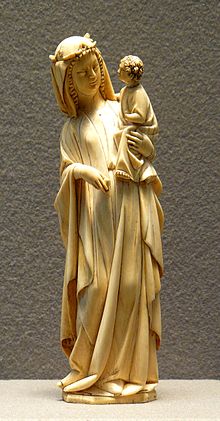
The Gothic period is essentially defined byGothic architecture,and does not entirely fit with the development of style in sculpture in either its start or finish. The facades of large churches, especially around doors, continued to have large typanums, but also rows of sculpted figures spreading around them. The statues on the Western (Royal) Portal atChartres Cathedral(c. 1145) show an elegant but exaggerated columnar elongation, but those on the southtranseptportal, from 1215 to 1220, show a more naturalistic style and increasing detachment from the wall behind, and some awareness of the classical tradition. These trends were continued in the west portal atReims Cathedralof a few years later, where the figures are almost in the round, as became usual as Gothic spread across Europe.[72]
In ItalyNicola Pisano(1258–1278) and his sonGiovannideveloped a style that is often calledProto-Renaissance,with unmistakable influence from Roman sarcophagi and sophisticated and crowded compositions, including a sympathetic handling of nudity, in relief panels on theirSiena Cathedral Pulpit(1265–68),Pulpit in the Pisa Baptistery(1260), theFontana MaggioreinPerugia,and Giovanni'spulpit in Pistoiaof 1301.[73]Another revival of classical style is seen in theInternational Gothicwork ofClaus Sluterand his followers inBurgundyandFlandersaround 1400.[74]Late Gothic sculpture continued in the North, with a fashion for very large wooden sculpted altarpieces with increasingly virtuoso carving and large numbers agitated expressive figures; most surviving examples are in Germany, after much iconoclasm elsewhere.Tilman Riemenschneider,Veit Stossand others continued the style well into the 16th century, gradually absorbing Italian Renaissance influences.[75]
Life-size tomb effigies in stone oralabasterbecame popular for the wealthy, and grand multi-level tombs evolved, with theScaliger TombsofVeronaso large they had to be moved outside the church. By the 15th century there was an industry exportingNottingham alabasteraltar reliefs in groups of panels over much of Europe for economical parishes who could not afford stone retables.[76]Small carvings, for a mainly lay and often female market, became a considerable industry in Paris and some other centres. Types of ivories included small devotionalpolyptychs,single figures, especially of the Virgin,mirror-cases, combs, andelaborate caskets with scenes from Romances,used as engagement presents.[77]The very wealthy collected extravagantly elaborate jewelled and enamelled metalwork, both secular and religious, like theDuc de Berry'sHoly Thorn Reliquary,until they ran short of money, when they were melted down again for cash.[78]
-
West portal ofChartres Cathedral(c. 1145)
-
South portal ofChartres Cathedral(c. 1215–1220)
-
West portal atReims Cathedral,Annunciationgroup
-
TheBamberg Horseman1237, near life-size stoneequestrian statue,the first of this kind sinceantiquity.
-
Lid of theWalters Casket,with theSiege of the Castle of Loveat left, andjousting.Paris, 1330–1350
-
Siege of the Castle of Loveon a mirror-case in theLouvre,1350–1370; the ladies are losing.
-
Central GermanPietà,1330–1340
-
Base of theHoly Thorn Reliquary,aResurrection of the Deadin gold, enamel and gems
-
Section of a panelled altarpiece withResurrection of Christ,English, 1450–1490,Nottingham alabasterwith remains of colour
-
Detail of theLast SupperfromTilman Riemenschneider'sAltar of the Holy Blood,1501–1505,Rothenburg ob der Tauber,Bavaria
Renaissance
[edit]
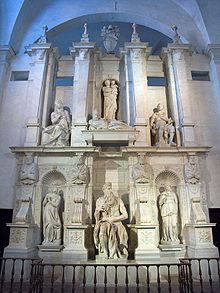
Renaissance sculpture proper is often taken to begin with the famous competition for the doors of theFlorence Baptistryin 1403, from which the trial models submitted by the winner,Lorenzo Ghiberti,andFilippo Brunelleschisurvive. Ghiberti's doors are still in place, but were undoubtedly eclipsed by his second pair for the other entrance, the so-calledGates of Paradise,which took him from 1425 to 1452, and are dazzlingly confident classicizing compositions with varied depths of relief allowing extensive backgrounds.[79]The intervening years had seen Ghiberti's early assistantDonatellodevelop with seminal statues including hisDavidsin marble (1408–09) and bronze (1440s), and hisEquestrian statue of Gattamelata,as well as reliefs.[80]A leading figure in the later period wasAndrea del Verrocchio,best known for hisequestrian statueofBartolomeo Colleoniin Venice;[81]his pupilLeonardo da Vincidesigned an equine sculpture in 1482The HorseforMilan,but only succeeded in making a 24-foot (7.3 m) clay model which was destroyed by French archers in 1499, and his other ambitious sculptural plans were never completed.[82]
The period was marked by a great increase in patronage of sculpture by the state for public art and by the wealthy for their homes; especially in Italy, public sculpture remains a crucial element in the appearance of historic city centres. Church sculpture mostly moved inside just as outside public monuments became common. Portrait sculpture, usually in busts, became popular in Italy around 1450, with theNeapolitanFrancesco Lauranaspecializing in young women in meditative poses, whileAntonio Rossellinoand others more often depicted knobbly-faced men of affairs, but also young children.[83]The portraitmedalinvented byPisanelloalso often depicted women; reliefplaquetteswere another new small form of sculpture in cast metal.
Michelangelo was an active sculptor from about 1500 to 1520, and his great masterpieces including hisDavid,Pietà,Moses,and pieces for theTomb of Pope Julius IIandMedici Chapelcould not be ignored by subsequent sculptors. His iconic David (1504) has acontrappostopose, borrowed from classical sculpture. It differs from previous representations of the subject in that David is depicted before his battle with Goliath and not after the giant's defeat. Instead of being shown victorious, as Donatello and Verocchio had done, David looks tense and battle ready.[84]
-
Francesco Laurana,female bust (cast)
Mannerist
[edit]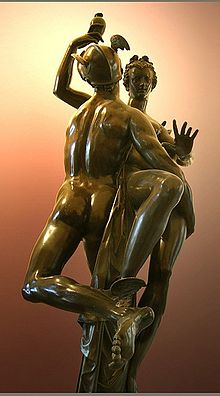
As in painting, early ItalianManneristsculpture was very largely an attempt to find an original style that would top the achievement of theHigh Renaissance,which in sculpture essentially meant Michelangelo, and much of the struggle to achieve this was played out in commissions to fill other places in thePiazza della Signoriain Florence, next to Michelangelo'sDavid.Baccio Bandinellitook over the project ofHercules and Cacusfrom the master himself, but it was little more popular than it is now, and maliciously compared byBenvenuto Cellinito "a sack of melons", though it had a long-lasting effect in apparently introducing relief panels on thepedestalof statues for the first time. Like other works of his, and other Mannerists, it removes far more of the original block than Michelangelo would have done.[85]Cellini's bronzePerseus with the head of Medusais certainly a masterpiece, designed with eight angles of view, another Mannerist characteristic, but is indeed mannered compared to theDavids of Michelangelo and Donatello.[86]Originally a goldsmith, his famous gold and enamelSalt Cellar(1543) was his first sculpture, and shows his talent at its best.[87]As these examples show, the period extended the range of secular subjects for large works beyond portraits, with mythological figures especially favoured; previously these had mostly been found in small works.
Small bronze figures for collector'scabinets,often mythological subjects with nudes, were a popular Renaissance form at whichGiambologna,originallyFlemishbut based in Florence, excelled in the later part of the century, also creating life-size sculptures, of which two joined the collection in the Piazza della Signoria. He and his followers devised elegant elongated examples of thefigura serpentinata,often of two intertwined figures, that were interesting from all angles.[88]
-
StuccooverdooratFontainebleau,probably designed byPrimaticcio,who painted the oval inset, 1530s or 1540s
-
Giambologna,Samson Slaying a Philistine,about 1562
Baroque and Rococo
[edit]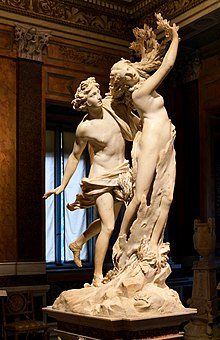
In Baroque sculpture, groups of figures assumed new importance, and there was a dynamic movement and energy of human forms— they spiralled around an empty central vortex, or reached outwards into the surrounding space. Baroque sculpture often had multiple ideal viewing angles, and reflected a general continuation of the Renaissance move away from the relief to sculpture created in the round, and designed to be placed in the middle of a large space—elaborate fountains such as Bernini'sFontana dei Quattro Fiumi(Rome, 1651), or those in theGardens of Versailleswere a Baroque speciality. TheBaroquestyle was perfectly suited to sculpture, withGian Lorenzo Berninithe dominating figure of the age in works such asThe Ecstasy of St Theresa(1647–1652).[89]Much Baroque sculpture added extra-sculptural elements, for example, concealed lighting, or water fountains, or fused sculpture and architecture to create a transformative experience for the viewer. Artists saw themselves as in the classical tradition, but admiredHellenisticand later Roman sculpture, rather than that of the more "Classical" periods as they are seen today.[90]
TheProtestant Reformationbrought an almost total stop to religious sculpture in much of Northern Europe, and though secular sculpture, especially for portrait busts andtomb monuments,continued, theDutch Golden Agehas no significant sculptural component outside goldsmithing.[91]Partly in direct reaction, sculpture was as prominent inRoman Catholicismas in the late Middle Ages. Statues of rulers and the nobility became increasingly popular. In the 18th century much sculpture continued on Baroque lines—theTrevi Fountainwas only completed in 1762.Rococostyle was better suited to smaller works, and arguably found its ideal sculptural form inearly European porcelain,and interior decorative schemes in wood or plaster such as those in French domestic interiors andAustrian and Bavarian pilgrimage churches.[92]
-
Bust ofLouis XIV,1686, byAntoine Coysevox
-
Saint Veronica byFrancesco Mochi(1640),Saint Peter's Basilica
-
Pierre Paul Puget,Perseus and Andromeda,1715,Musée du Louvre
Neo-Classical
[edit]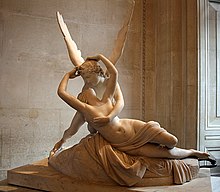
TheNeoclassical stylethat arrived in the late 18th century gave great emphasis to sculpture.Jean-Antoine Houdonexemplifies the penetrating portrait sculpture the style could produce, andAntonio Canova's nudes the idealist aspect of the movement. The Neoclassical period was one of the great ages of public sculpture, though its "classical" prototypes were more likely to be Roman copies of Hellenistic sculptures. In sculpture, the most familiar representatives are the ItalianAntonio Canova,the EnglishmanJohn Flaxmanand the DaneBertel Thorvaldsen.The European neoclassical manner also took hold in the United States, where its pinnacle occurred somewhat later and is exemplified in the sculptures ofHiram Powers.
Asia
[edit]Greco-Buddhist sculpture and Asia
[edit]
Greco-Buddhist artis the artistic manifestation ofGreco-Buddhism,a culturalsyncretismbetween theClassical Greekculture andBuddhism,which developed over a period of close to 1000 years in Central Asia, between theconquests of Alexander the Greatin the 4th century BCE, and the Islamic conquests of the 7th century CE. Greco-Buddhist art is characterized by the strong idealistic realism of Hellenistic art and the first representations of the Buddha in human form, which have helped define the artistic (and particularly, sculptural) canon for Buddhist art throughout the Asian continent up to the present. Though dating is uncertain, it appears that strongly Hellenistic styles lingered in the East for several centuries after they had declined around the Mediterranean, as late as the 5th century CE. Some aspects of Greek art were adopted while others did not spread beyond the Greco-Buddhist area; in particular the standing figure, often with a relaxed pose and one leg flexed, and the flying cupids or victories, who became popular across Asia asapsaras.Greek foliage decoration was also influential, with Indian versions of theCorinthian capitalappearing.[93]
The origins of Greco-Buddhist art are to be found in the HellenisticGreco-Bactrian kingdom(250–130 BCE), located in today'sAfghanistan,from which Hellenistic culture radiated into theIndian subcontinentwith the establishment of the smallIndo-Greek kingdom(180–10 BCE). Under theIndo-Greeksand then theKushans,the interaction of Greek and Buddhist culture flourished in the area ofGandhara,in today's northern Pakistan, before spreading further into India, influencing the art ofMathura,and then theHinduart of theGupta empire,which was to extend to the rest of South-East Asia. The influence of Greco-Buddhist art also spread northward towardsCentral Asia,strongly affecting the art of theTarim Basinand theDunhuang Caves,and ultimately the sculpted figure in China, Korea, and Japan.[94]
-
Gandhara frieze with devotees, holdingplantainleaves, in purely Hellenistic style, insideCorinthian columns,1st–2nd century CE.Buner,Swat,Pakistan.Victoria and Albert Museum
-
Coin ofDemetrius I of Bactria,who reigned circa 200–180 BCE and invaded Northern India
-
StuccoBuddha head, once painted, fromHadda, Afghanistan,3rd–4th centuries
-
GandharaPoseidon(Ancient Orient Museum)
-
Taller Buddha of Bamiyan,c. 547 CE,in 1963 and in 2008 after they were dynamited and destroyed in March 2001 by theTaliban
China
[edit]
Chinese ritual bronzesfrom theShangandWestern Zhou dynastiescome from a period of over a thousand years fromc. 1500 BCE,and have exerted a continuing influence overChinese art.They are cast with complex patterned andzoomorphicdecoration, but avoid the human figure, unlike the huge figures only recently discovered atSanxingdui.[95]The spectacularTerracotta Armywas assembled for the tomb ofQin Shi Huang,the first emperor of a unified China from 221 to 210 BCE, as a grand imperial version of the figures long placed in tombs to enable the deceased to enjoy the same lifestyle in the afterlife as when alive, replacing actual sacrifices of very early periods. Smaller figures in pottery or wood were placed in tombs for many centuries afterwards, reaching a peak of quality inTang dynasty tomb figures.[96]The tradition of unusually large pottery figures persisted in China, through Tangsancaitomb figures to later Buddhist statues such as the near life-size set ofYixian glazed pottery luohansand later figures for temples and tombs. These came to replace earlier equivalents in wood.
Native Chinese religions do not usually use cult images of deities, or even represent them, and large religious sculpture is nearly all Buddhist, dating mostly from the 4th to the 14th century, and initially using Greco-Buddhist models arriving via theSilk Road.Buddhism is also the context of all large portrait sculpture; in total contrast to some other areas, in medieval China even painted images of the emperor were regarded as private. Imperial tombs have spectacular avenues of approach lined with real and mythological animals on a scale matching Egypt, and smaller versions decorate temples and palaces.[97]
Small Buddhist figures and groups were produced to a very high quality in a range of media,[98]as was relief decoration of all sorts of objects, especially in metalwork andjade.[99]In the earlier periods, large quantities of sculpture were cut from the living rock in pilgrimage cave-complexes, and as outsiderock reliefs.These were mostly originally painted. In notable contrast toliteratipainters, sculptors of all sorts were regarded as artisans and very few names are recorded.[100]From theMing dynastyonwards, statuettes of religious and secular figures were produced inChinese porcelainand other media, which became an important export.
-
A bronzedingfrom lateShang dynasty(13th century–10th century BCE)
-
A tomb guardian usually placed inside the doors of the tomb to protect or guide the soul,Warring States period,c. 3rd century BCE
-
Gold stag with eagle's head, and ten further heads in the antlers. An object inspired by the art of the Siberian Altai mountain, possiblyPazyryk,unearthed at the site of Nalinggaotu,Shenmu County,nearXi'an,China.[101]Possibly from the "Hun people who lived in the prairie in Northern China". Dated to the 4th-3rd century BCE,[101]orHan dynastyperiod.[102]Shaanxi History Museum.[102]
-
Tomb figure of dancing girl,Han dynasty(202 BCE—220 CE)
-
Bronzecowriecontainer withyaks,from theDian Kingdom(4th century BCE – 109 BCE) tradition of theWestern Han
-
Northern Wei dynastyMaitreya(386–534)
-
Tang dynasty tomb figureinsancaiglaze pottery, horse and groom (618–907)
-
SeatedBuddha,Tang dynastyc. 650.
-
A woodenBodhisattvafrom theSong dynasty(960–1279)
-
Chinese jadeCup with Dragon Handles,Song dynasty,12th century
-
Blue underglaze statue of a man with his pipe,Jingdezhen porcelain,MingWanli period(1573–1620)
Japan
[edit]
Towards the end of the longNeolithicJōmon period,somepottery vesselswere "flame-rimmed" with extravagant extensions to the rim that can only be called sculptural,[103]and very stylized potterydogūfigures were produced, many with the characteristic "snow-goggle" eyes. During the Kofun period of the 3rd to 6th century CE,haniwaterracotta figures of humans and animals in a simplistic style were erected outside important tombs. The arrival of Buddhism in the 6th century brought with it sophisticated traditions in sculpture, Chinese styles mediated via Korea. The 7th-centuryHōryū-jiand its contents have survived more intact than any East Asian Buddhist temple of its date, with works including aShaka Trinityof 623 in bronze, showing the historical Buddha flanked by two bodhisattvas and also theGuardian Kings of the Four Directions.[104]
Jōchōis said to be one of the greatest Buddhist sculptors not only inHeian periodbut also in the history of Buddhist statues in Japan. Jōchō redefined the body shape of Buddha statues by perfecting the technique of "yosegi zukuri" ( ký mộc tạo り) which is a combination of several woods. The peaceful expression and graceful figure of the Buddha statue that he made completed a Japanese style of sculpture of Buddha statues called "Jōchō yō" (Jōchō style, định triều dạng ) and determined the style of Japanese Buddhist statues of the later period. His achievement dramatically raised the social status ofbusshi(Buddhist sculptor) in Japan.[105]
In theKamakura period,theMinamoto clanestablished theKamakura shogunateand thesamuraiclass virtually ruled Japan for the first time. Jocho's successors, sculptors of theKei schoolof Buddhist statues, created realistic and dynamic statues to suit the tastes of samurai, and Japanese Buddhist sculpture reached its peak.Unkei,Kaikei,andTankeiwere famous, and they made many new Buddha statues at many temples such asKofuku-ji,where many Buddha statues had been lost in wars and fires.[106]
Almost all subsequent significant large sculpture in Japan was Buddhist, with someShintoequivalents, and after Buddhism declined in Japan in the 15th century, monumental sculpture became largely architectural decoration and less significant.[107]However sculptural work in the decorative arts was developed to a remarkable level of technical achievement and refinement in small objects such asinroandnetsukein many materials, and metaltosoguorJapanese sword mountings.In the 19th century there were export industries of small bronze sculptures of extreme virtuosity, ivory and porcelain figurines, and other types of small sculpture, increasingly emphasizing technical accomplishment.
-
'Flame-style' vessel, NeolithicJōmon period;c. 2750 BCE;earthenware with carved and applied decoration; height: 61 cm, diameter: 55.8 cm
-
Dogūwith "snow-goggle" eyes, 1000–400 BCE
-
6th-centuryhaniwafigure
-
Kongo Rishiki (Guardian Deity) at the Central Gate ofHōryū-ji
-
Tsubasword fitting with a "Rabbit Viewing the Autumn Moon", bronze, gold and silver, between 1670 and 1744
-
Izumiya Tomotada,netsukein the form of a dog, late 18th century
-
Eagle by Suzuki Chokichi, 1892,Tokyo National Museum
Indian subcontinent
[edit]
The first knownsculpture in the Indian subcontinentis from theIndus Valley civilization(3300–1700 BCE), found in sites atMohenjo-daroandHarappain modern-dayPakistan.These include the famoussmall bronze female dancerand the so-calledPriest-king.However, such figures in bronze and stone are rare and greatly outnumbered by pottery figurines and stone seals, often of animals or deities very finely depicted. After the collapse of the Indus Valley civilization there is little record of sculpture until the Buddhist era, apart from a hoard of copper figures of (somewhat controversially)c. 1500 BCEfromDaimabad.[108]Thus the great tradition of Indian monumental sculpture in stone appears to begin, relative to other cultures, and the development of Indian civilization, relatively late, with the reign ofAsokafrom 270 to 232 BCE, and thePillars of Ashokahe erected around India, carrying his edicts and topped by famous sculptures of animals, mostly lions, of which six survive.[109]Large amounts of figurative sculpture, mostly in relief, survive from Early Buddhist pilgrimage stupas, above allSanchi;these probably developed out of a tradition using wood that also embracedHinduism.[110]
The pink sandstone Hindu,Jainand Buddhist sculptures ofMathurafrom the 1st to 3rd centuries CE reflected both native Indian traditions and the Western influences received through the Greco-Buddhist art of Gandhara, and effectively established the basis for subsequent Indian religious sculpture.[110]The style was developed and diffused through most of India under theGupta Empire(c. 320–550) which remains a"classical" period for Indian sculpture,covering the earlierEllora Caves,[111]though theElephanta Cavesare probably slightly later.[112]Later large-scale sculpture remains almost exclusively religious, and generally rather conservative, often reverting to simple frontal standing poses for deities, though the attendant spirits such as apsaras andyakshioften have sensuously curving poses. Carving is often highly detailed, with an intricate backing behind the main figure in high relief. The celebrated bronzes of theCholadynasty (c. 850–1250) from south India, many designed to be carried in processions, include the iconic form ofShivaasNataraja,[113]with the massive granite carvings ofMahabalipuramdating from the previousPallava dynasty.[114]
-
The "Dancing Girl"ofMohenjo-daro,3rd or 2nd millennium BCE (replica)
-
Buddha fromSarnath,5th–6th century CE
-
The Colossaltrimurtiat theElephanta Caves
-
Rock-cut temples atEllora
-
Hindu,Cholaperiod, 1000
-
Typical medieval frontal standing statue ofVishnu,950–1150
-
KhajurahoTemple
-
Gopuramof theThillai Nataraja Temple, Chidambaram,Tamil Nadu,densely packed with rows of painted statues
-
Sculpture of Guardian at the entrance of the Mandapam of Sri Jalagandeeswarar Temple, Vellore, Tamil Nadu
South-East Asia
[edit]
The sculpture of the region tends to be characterised by a high degree of ornamentation, as seen in the great monuments of Hindu and BuddhistKhmer sculpture(9th to 13th centuries) atAngkor Watand elsewhere, the enormous 9th-century Buddhist complex atBorobudurinJava,and the Hindu monuments ofBali.[115]Both of these include many reliefs as well as figures in the round; Borobudur has 2,672 relief panels, 504 Buddha statues, many semi-concealed in openworkstupas,and many large guardian figures.
In Thailand and Laos, sculpture was mainly ofBuddha images,often gilded, both large for temples and monasteries, and small figurines for private homes. Traditional sculpture inMyanmaremerged before theBagan period.As elsewhere in the region, most of the wood sculptures of the Bagan and Ava periods have been lost.
TraditionalAnitistsculptures from the Philippines are dominated by Anitist designs mirroring the medium used and the culture involved, while being highlighted by the environments where such sculptures are usually placed on. Christian and Islamic sculptures from the Philippines have different motifs compared to other Christian and Islamic sculptures elsewhere. In later periods Chinese influence predominated in Vietnam, Laos and Cambodia, and more wooden sculpture survives from across the region.
-
TheAnitistAgusan imagefrom Agusan del Sur, Philippines, 9th-10th century
-
Head ofJayavarman VII,Khmer art, Cambodia,c. late 12th century
-
An Islamic sculpture of aburaq,southern Philippines
-
Phra Achana, Wat Si Chum, Big Buddha image inSukhothai,Thailand,c. 14th century
-
"the Buddha calling the earth to witness", The Buddha's hands are in thebhūmisparsa mudrā(subduing Māra) position. Ho Phra Kaeo temple,Vientiane,Laos
Islam
[edit]
Islamisfamously aniconic,so the vast majority of sculpture isarabesquedecoration in relief or openwork, based on vegetable motifs, but tending to geometrical abstract forms. In the very earlyMshatta Facade(740s), now mostly inBerlin,there are animals within the dense arabesques in high relief, and figures of animals and men in mostly low relief are found in conjunction with decoration on many later pieces in various materials, including metalwork, ivory and ceramics.[116]
Figures of animals in the round were often acceptable for works used in private contexts if the object was clearly practical, so medieval Islamic art contains many metal animals that areaquamaniles,incenseburners or supporters for fountains, as in the stone lions supporting the famous one in theAlhambra,culminating in the largest medieval Islamic animal figure known, thePisa Griffin.In the same way, luxuryhardstone carvingssuch as dagger hilts and cups may be formed as animals, especially inMughal art.The degree of acceptability of such relaxations of strict Islamic rules varies between periods and regions, withIslamic Spain,Persia and India often leading relaxation, and is typically highest in courtly contexts.[117]
-
TheMshatta Facade,from a palace nearDamascus,740s
-
ThePisa Griffin,107 cm high, probably 11th century
Africa
[edit]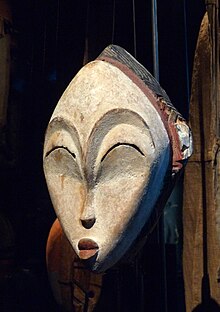
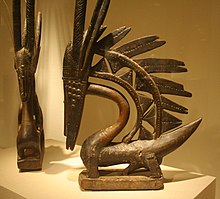
Historically, with the exception of some monumental Egyptian sculpture, most African sculpture was created in wood and other organic materials that have not survived from earlier than a few centuries ago; older pottery figures are found from a number of areas.Masksare important elements in the art of many peoples, along with human figures, often highly stylized. There is a vast variety of styles, often varying within the same context of origin depending on the use of the object, but wide regional trends are apparent; sculpture is most common among "groups of settled cultivators in the areas drained by theNigerandCongorivers "in West Africa.[118]Direct images of deities are relatively infrequent, but masks in particular are or were often made for religious ceremonies; today many are made for tourists as "airport art".[119]African masks were an influence on EuropeanModernistart, which was inspired by their lack of concern for naturalistic depiction.
TheNubianKingdom of Kushin modern Sudan was in close and often hostile contact with Egypt, and produced monumental sculpture mostly derivative of styles to the north. In West Africa, the earliest known sculptures are from theNok culturewhich thrived between 500 BCE and 500 CE in modern Nigeria, with clay figures typically with elongated bodies and angular shapes. Later West African cultures developed bronze casting for reliefs to decorate palaces like the famousBenin Bronzes,and very fine naturalistic royal heads from around theYorubatown ofIfein terracotta and metal from the 12th–14th centuries.Akan goldweightsare a form of small metal sculptures produced over the period 1400–1900, some apparently representingproverbsand so with a narrative element rare in African sculpture, and royal regalia included impressive gold sculptured elements.[120]
Many West African figures are used in religious rituals and are often coated with materials placed on them for ceremonial offerings. TheMande-speaking peoples of the same region make pieces of wood with broad, flat surfaces and arms and legs are shaped like cylinders. In Central Africa, however, the main distinguishing characteristics include heart-shaped faces that are curved inward and display patterns of circles and dots.
Populations in theAfrican Great Lakesare not known for their sculpture.[118]However, one style from the region is pole sculptures, carved in human shapes and decorated with geometric forms, while the tops are carved with figures of animals, people, and various objects. These poles are, then, placed next to graves and are associated with death and the ancestral world. The culture known fromGreat Zimbabweleft more impressive buildings than sculpture but the eightsoapstoneZimbabwe Birdsappear to have had a special significance and were mounted onmonoliths.Modern Zimbabwean sculptors in soapstone have achievedconsiderable international success.Southern Africa's oldest known clay figures date from 400 to 600 CE and have cylindrical heads with a mixture of human and animal features.
-
Nokterracotta, 6th century BCE–6th century CE
-
Ifehead,terracotta,probably 12–14th centuries CE
-
Sculpture of a 'Queen Mother' from Benin, 16th century.
-
16th-century ivory mask from Benin
-
One of theBenin Bronzes,16th–18th century, Nigeria.
-
Mask fromBurkina Faso,19th century
-
Mambilafigure, Nigeria
Ethiopia and Eritrea
[edit]The creation of sculptures in Ethiopia andEritreacan be traced back to its ancient past with the kingdoms ofDʿmtandAksum.Christian artwas established in Ethiopia with the conversion frompaganismtoChristianityin the 4th century CE, during the reign of kingEzana of Axum.[121]Christian imagery decorated churches during the Asksumite period and later eras.[122]For instance, atLalibela,life-sizesaintswere carved into the Church of Bet Golgotha; by tradition these were made during the reign of theZagwerulerGebre Mesqel Lalibelain the 12th century, but they were more likely crafted in the 15th century during theSolomonic dynasty.[123]However, theChurch of Saint George, Lalibela,one of several examples ofrock cut architectureat Lalibela containing intricate carvings, was built in the 10th–13th centuries as proven by archaeology.[124]
-
Stone statue fromAddi-Galamo,Tigray Province,6th–5th century BCE
-
A jar spout from the earlyKingdom of Aksum
-
TheObelisk of Axum,4th century CE
-
Aprocessional cross,Zagwe dynasty,12th century
-
One of the seven life-sizesaintscarved into the wall of the Church of Bet Golgotha,Lalibela,15th century (traditionally believed to have been made during the reign ofGebre Mesqel Lalibela)[123]
Sudan
[edit]Inancient Sudan,the development of sculpture stretches from the simple pottery of theKerma culturebeginning around 2500 BCE to the monumental statuary and architecture of theKingdom of Kush,its last phase—theMeroitic period—ending around 350 CE (with its conquest by Ethiopia's Aksum).[125][126]Beyond pottery items, the Kerma culture also made furniture that contained sculptures, such as gold cattle hoofs as the legs of beds.[125]Sculpture during the Kingdom of Kush included full-sized statues (especially of kings and queens), smaller figurines (most commonly depicting royal servants), and reliefs in stone, which were influenced by the contemporary ancient Egyptian sculptural tradition.[127][128]
-
A ceramic jug of theKerma culture
-
Column and elephant - part of the temple complex inMusawwarat es-Sufra,3rd century BCE
-
Traces of paint on a relief depicting PrinceArikhankharersmiting his enemies, from theMeroitic periodof theKingdom of Kush,early 1st century CE
-
Relief of a ruler, aCandace of MeroënamedKandake Amanitore,1st century CE
The Americas
[edit]Sculpture in present-dayLatin Americadeveloped in two separate and distinct areas,Mesoamericain the north andPeruin the south. In both areas, sculpture was initially of stone, and later ofterracottaand metal as the civilizations in these areas became more technologically proficient.[129]TheMesoamerican regionproduced more monumental sculpture, from the massive block-like works of theOlmecandTolteccultures, to the superb lowreliefsthat characterize theMayanandAzteccultures. In the Andean region, sculptures were typically small, but often show superb skill.
Pre-Columbian
[edit]-
OlmecBaby Figure 1200-900 BCE
-
Olmec Jadeite Mask 1000–600 BCE
-
Olmec Colossal HeadNo. 3 1200–900 BCE
-
La Mojarra Stela 12nd century CE
-
Chalchiuhtlicue from Teotihuacán 200–500 CE
-
Teotihuacanmask 200–600 CE
-
Teotihuacan- Detail of the Temple of theFeathered Serpent200–250 CE
-
Afunerary urnin the shape of a "bat god" or a jaguar,Oaxaca,300–650 CE
-
Moche portrait vesselwithstirrup spout,Peru, 100 BCE–700 CE
-
K'inich Janaab Pakal IofPalenque,Maya, 603–683 CE
-
Ahkal Mo' Naab III Of Palenque, 8th century CE
-
Upakal K'inich 8th century CE, Palenque
-
Jaina Islandtype figure (Mayan) 650–800 CE
-
Classic Veracruz cultureface 600–900 CE
-
Atlante fromTula,c. 1000 CE
North America
[edit]
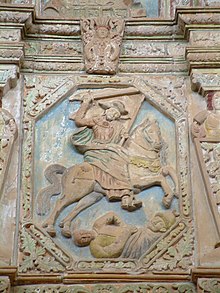
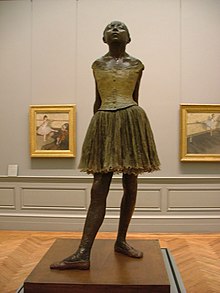
InNorth America,wood was sculpted fortotem poles,masks, utensils,War canoesand a variety of other uses, with distinct variation between different cultures and regions. The most developed styles are those of thePacific Northwest Coast,where a group of elaborate and highly stylized formal styles developed forming the basis of a tradition that continues today. In addition to the famous totem poles, painted and carvedhouse frontswere complemented by carved posts inside and out, as well as mortuary figures and other items. Among theInuitof the far north, traditional carving styles in ivory and soapstone are still continued.[130]
The arrival of European Catholic culture readily adapted local skills to the prevailingBaroquestyle, producing enormously elaborateretablosand other mostly church sculptures in a variety of hybrid styles.[131]The most famous of such examples in Canada is the altar area of theNotre Dame Basilicain Montreal, Quebec, which was carved by peasanthabitantlabourers. Later, artists trained in the Western academic tradition followed European styles until in the late 19th century they began to draw again on indigenous influences, notably in the Mexican baroque grotesque style known asChurrigueresque.Aboriginal peoples also adapted church sculpture in variations onCarpenter Gothic;one famous example is theChurch of the Holy CrossinSkookumchuck Hot Springs, British Columbia.
The history ofsculpture in the United Statesafter Europeans' arrival reflects the country's 18th-century foundation inRomanrepublican civic values andProtestant Christianity.Compared to areas colonized by the Spanish, sculpture got off to an extremely slow start in the British colonies, with next to no place in churches, and was only given impetus by the need to assert nationality after independence. American sculpture of the mid- to late-19th century was often classical, often romantic, but showed a bent for a dramatic, narrative, almost journalistic realism. Public buildings during the last quarter of the 19th century and the first half of the 20th century often provided an architectural setting for sculpture, especially in relief. By the 1930s theInternational Styleof architecture and design andart decocharacterized by the work ofPaul ManshipandLee Lawrieand others became popular. By the 1950s, traditional sculpture education would almost be completely replaced by aBauhaus-influenced concern forabstractdesign.Minimalistsculpture replaced the figure in public settings and architects almost completely stopped using sculpture in or on their designs. Modern sculptors (21st century) use both classical and abstract inspired designs. Beginning in the 1980s, there was a swing back toward figurative public sculpture; by 2000, many of the new public pieces in the United States were figurative in design.
-
Gutzon Borglumand his son,Lincoln Borglum,Mount Rushmore,1927–1941. L–R,George Washington,Thomas Jefferson,Theodore Roosevelt,andAbraham Lincoln.
-
Robert Gould Shaw MemorialbyAugustus Saint-Gaudens,1884–1897, plaster version
-
TheK'alyaanTotem Pole of theTlingitKiks.ádi Clan, erected atSitka National Historical Parkto commemorate the lives lost in the 1804Battle of Sitka
-
Frederic Remington,The Bronco Buster,1895, cast 1918. Metropolitan Museum of Art
-
Paul Manship,Dancer and Gazelles,1916,Smithsonian American Art Museum,Washington, DC
Moving toward modern art
[edit]19th–early 20th century, early Modernism and continuing realism
[edit]-
Per Hasselberg,Snöklockan(snowdrop), Paris 1881. Copy from 1953 in bronze by C & A Nicci (Rome/Italy) placed in Rottneros Park nearSunneinVärmland/Sweden.
-
Antoine Bourdelle,Day and Night,marble, 1903,Musée Bourdelle,Paris
-
Camille Claudel,The Waltz,1905 cast of the second version
-
Jan Štursa,Before the Bath,1906,National Gallery in Prague
-
Aristide Maillol,The Night (La Nuit)1909,Tuileries Garden,Paris
-
Robert Wlérick,The Thought1933,Morez
Modern classicism contrasted in many ways with the classical sculpture of the 19th century which was characterized by commitments to naturalism (Antoine-Louis Barye)—the melodramatic (François Rude) sentimentality (Jean-Baptiste Carpeaux)—or a kind of stately grandiosity (Lord Leighton). Several different directions in the classical tradition were taken as the century turned, but the study of the live model and the post-Renaissance tradition was still fundamental to them. Auguste Rodinwas the most renowned European sculptor of the early 20th century.[132][133]He is often considered a sculpturalImpressionist,as are his students includingCamille Claudel,andHugo Rheinhold,attempting to model of a fleeting moment of ordinary life. Modern classicism showed a lesser interest in naturalism and a greater interest in formal stylization. Greater attention was paid to the rhythms of volumes and spaces—as well as greater attention to the contrasting qualities of surface (open, closed, planar, broken etc.) while less attention was paid to story-telling and convincing details of anatomy or costume. Greater attention was given to psychological effect than to physical realism, and influences from earlier styles worldwide were used.
Early masters of modern classicism included:Aristide Maillol,Alexander Matveyev,Joseph Bernard,Antoine Bourdelle,Georg Kolbe,Libero Andreotti,Gustav Vigeland,Jan Stursa,Constantin Brâncuși.As the century progressed, modern classicism was adopted as the national style of the two great European totalitarian empires:Nazi GermanyandSoviet Russia,who co-opted the work of earlier artists such as Kolbe andWilhelm Lehmbruckin Germany[134]and Matveyev in Russia. Over the 70 years of the USSR, new generations of sculptors were trained and chosen within their system, and a distinct style,socialist realism,developed, that returned to the 19th century's emphasis on melodrama and naturalism.
Classical training was rooted out of art education in Western Europe (and the Americas) by 1970 and the classical variants of the 20th century were marginalized in the history of modernism. But classicism continued as the foundation of art education in the Soviet academies until 1990, providing a foundation for expressive figurative art throughout eastern Europe and parts of the Middle East. By 2000, the European classical tradition retains a wide appeal to the public but awaits an educational tradition to revive its contemporary development.
Some of the modern classical became either more decorative/art deco (Paul Manship,Jose de Creeft,Carl Milles) or more abstractly stylized or more expressive (and Gothic) (Anton Hanak,Wilhelm Lehmbruck,Ernst Barlach,Arturo Martini)—or turned more to the Renaissance (Giacomo Manzù,Venanzo Crocetti) or stayed the same (Charles Despiau,Marcel Gimond).
Modernism
[edit]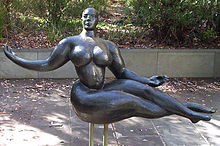
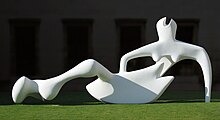

Modernistsculpture movements includeCubism,Geometric abstraction,De Stijl,Suprematism,Constructivism,Dadaism,Surrealism,Futurism,Formalism,Abstract expressionism,Pop-Art,Minimalism,Land art,andInstallation artamong others.
In the beginning of the 20th century,Pablo Picassorevolutionized the art of sculpture when he began creating his constructions fashioned by combining disparate objects and materials into one constructed piece of sculpture; the sculptural equivalent of thecollagein two-dimensional art. The advent ofSurrealismled to things occasionally being described as "sculpture" that would not have been so previously, such as "involuntary sculpture" in several senses, includingcoulage.In later years Picasso became a prolificpotter,leading, with interest in historic pottery from around the world, to a revival ofceramic art,with figures such asGeorge E. Ohrand subsequentlyPeter Voulkos,Kenneth Price,andRobert Arneson.Marcel Duchamporiginated the use of the "found object"(French: objet trouvé) orreadymadewith pieces such asFountain(1917).
Similarly, the work ofConstantin Brâncușiat the beginning of the century paved the way for later abstract sculpture. In revolt against the naturalism of Rodin and his late-19th-century contemporaries, Brâncuși distilled subjects down to their essences as illustrated by the elegantly refined forms of hisBird in Spaceseries (1924).[135]
Brâncuși's impact, with his vocabulary of reduction and abstraction, is seen throughout the 1930s and 1940s, and exemplified by artists such asGaston Lachaise,Sir Jacob Epstein,Henry Moore,Alberto Giacometti,Joan Miró,Julio González,Pablo Serrano,Jacques Lipchitz[136]and by the 1940s abstract sculpture was impacted and expanded byAlexander Calder,Len Lye,Jean Tinguely,andFrederick Kieslerwho were pioneers ofKinetic art.
Modernist sculptors largely missed out on the huge boom in public art resulting from the demand forwar memorialsfor the two World Wars, but from the 1950s the public and commissioning bodies became more comfortable with Modernist sculpture and large public commissions both abstract and figurative became common. Picasso was commissioned to make amaquettefor a huge 50-foot (15 m)-high public sculpture, the so-calledChicago Picasso(1967). His design was ambiguous and somewhat controversial, and what the figure represents is not clear; it could be a bird, a horse, a woman or a totally abstract shape.
During the late 1950s and the 1960s abstract sculptors began experimenting with a wide array of new materials and different approaches to creating their work. Surrealist imagery, anthropomorphic abstraction, new materials and combinations of new energy sources and varied surfaces and objects became characteristic of much new modernist sculpture. Collaborative projects with landscape designers, architects, and landscape architects expanded the outdoor site and contextual integration. Artists such asIsamu Noguchi,David Smith,Alexander Calder,Jean Tinguely,Richard Lippold,George Rickey,Louise Bourgeois,Philip PaviaandLouise Nevelsoncame to characterize the look of modern sculpture.
By the 1960sAbstract expressionism,Geometric abstractionandMinimalism,which reduces sculpture to its most essential and fundamental features, predominated. Some works of the period are: the Cubi works of David Smith, and the welded steel works ofSir Anthony Caro,as well aswelded sculptureby a large variety of sculptors, the large-scale work ofJohn Chamberlain,and environmental installation scale works byMark di Suvero.Other Minimalists includeTony Smith,Donald Judd,Robert Morris,Anne Truitt,Giacomo Benevelli,Arnaldo Pomodoro,Richard Serra,Dan Flavin,Carl Andre,andJohn Saferwho added motion and monumentality to the theme of purity of line.[137]
During the 1960s and 1970s figurative sculpture by modernist artists in stylized forms was made by artists such asLeonard Baskin,Ernest Trova,George Segal,Marisol Escobar,Paul Thek,Robert Grahamin a classic articulated style, andFernando Boterobringing his painting's 'oversized figures' into monumental sculptures.
Gallery of modernist sculpture
[edit]-
André Derain,Nu debout,1907, limestone,Musée National d'Art Moderne
-
Henri Matisse,Figure décorative,1908, bronze
-
Amedeo Modigliani,Female Head,1911–12,Metropolitan Museum of Art
-
Joseph Csaky,Groupe de femmes (Groupe de trois femmes, Groupe de trois personnages),1911–12, plaster, lost
-
Alexander Archipenko,La Vie Familiale(Family Life), 1912, destroyed
-
Constantin Brâncuși,Portrait of Mademoiselle Pogany,1912, white marble; limestone block,Philadelphia Museum of Art.Exhibited at the 1913Armory Show
-
Otto Gutfreund,Cellist,1912–13
-
Marcel Duchamp,Fountain,1917
-
Jacob Epstein,Day and Night,carved for theLondon Underground's headquarters, 1928.
-
Mieczysław Kotarbiński,Coat of arms of Poland,basalt relief inArt Decostyle, Warsaw, 1931.
-
Käthe Kollwitz,The Grieving Parents,1932, World War I memorial (for her son Peter),Vladslo German war cemetery
-
Jacques Lipchitz,Birth of the Muses,1944–1950
-
Barbara Hepworth,Monolith-Empyrean,1953
-
Henry Moore,Three Piece Reclining figure No.1,1961,Yorkshire
-
Pablo Picasso,Chicago Picasso,1967, Chicago, Illinois
-
George Rickey,Four Squares in Geviert,1969, terrace of theNew National Gallery,Berlin, Germany, Rickey is considered aKinetic sculptor
-
Alexander Calder,Crinkly avec disc rouge,1973, Schlossplatz,Stuttgart
-
Louise Nevelson,Atmosphere and Environment XII,1970–1973,Philadelphia Museum of Art
-
Sir Anthony Caro,Black Cover Flat,1974, steel,Tel Aviv Museum of Art
-
Joan Miró,Woman and Bird,1982, Barcelona, Spain
Contemporary movements
[edit]
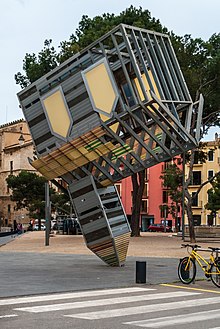
Palma de Mallorca,Plaça de la Porta de Santa Catalina
Site specificandenvironmental artworks are represented by artists:Andy Goldsworthy,Walter De Maria,[139]Richard Long,Richard Serra,Robert Irwin,[140]George RickeyandChristo and Jeanne-Claudeled contemporary abstract sculpture in new directions. Artists createdenvironmental sculptureon expansive sites in the 'land art in the American West' group of projects. Theseland artor 'earth art' environmental scale sculpture works exemplified by artists such asRobert Smithson,Michael Heizer,James Turrell(Roden Crater).Eva Hesse,Sol LeWitt,Jackie Winsor,Keith Sonnier,Bruce NaumanandDennis Oppenheimamong others were pioneers ofPostminimalistsculpture.
Also during the 1960s and 1970s artists as diverse asEduardo Paolozzi,Chryssa,Claes Oldenburg,George Segal,Edward Kienholz,Nam June Paik,Wolf Vostell,Duane Hanson,andJohn DeAndreaexplored abstraction, imagery and figuration throughvideo art,environment, light sculpture, andinstallation artin new ways.
Conceptual artis art in which the concept(s) or idea(s) involved in the work take precedence over traditional aesthetic and material concerns. Works includeOne and Three Chairs,1965, is byJoseph Kosuth,andAn Oak TreebyMichael Craig-Martin,and those ofJoseph Beuys,James TurrellandJacek Tylicki.
Minimalism
[edit]-
Tony Smith,Free Ride,1962, 6'8 x 6'8 x 6'8 (the height of a standard US door opening),Museum of Modern Art,New York
-
Larry Bell,Untitled1964, bismuth, chromium, gold, and rhodium on gold-plated brass;Hirshhorn Museum and Sculpture Garden
-
Richard Serra,Fulcrum1987, 55 ft high free standing sculpture ofCor-ten steelnearLiverpool Street station,London
-
Donald Judd,Untitled,1991,Israel MuseumArt Garden, Jerusalem
-
Richard Long,South Bank Circle,1991 Tate Liverpool, England
-
Jean-Yves Lechevallier,Fettered wing.1991
-
Anish Kapoor,Turning the World Upside Down,Israel Museum,2010
-
Rachel Whiteread,Judenplatz Holocaust Memorial,Vienna, 2000
-
TheSpire of Dublinofficially titled theMonument of Light,stainless steel, 121.2 metres (398 feet), the world's tallest sculpture
Contemporary genres
[edit]
Some modern sculpture forms are now practiced outdoors, asenvironmental artandenvironmental sculpture,often in full view of spectators.Light sculpture,street art sculptureandsite-specific artalso often make use of the environment.Ice sculptureis a form of ephemeral sculpture that uses ice as the raw material. It is popular in China, Japan, Canada, Sweden, and Russia. Ice sculptures feature decoratively in some cuisines, especially in Asia.Kinetic sculpturesare sculptures that are designed to move, which includemobiles.Snow sculpturesare usually carved out of a single block of snow about 6 to 15 feet (1.8 to 4.6 m) on each side and weighing about 20–30 tons. The snow is densely packed into a form after having been produced by artificial means or collected from the ground after a snowfall.Sound sculpturestake the form of indoor sound installations, outdoor installations such as aeolian harps, automatons, or be more or less near conventional musical instruments. Sound sculpture is often site-specific.Art toyshave become another format for contemporary artists since the late 1990s, such as those produced byTakashi MurakamiandKid Robot,designed byMichael Lau,or hand-made byMichael Leavitt (artist).[141]
Conservation
[edit]
Sculptures are sensitive to environmental conditions such astemperature,humidityand exposure to light andultraviolet light.Acid raincan also cause damage to certain building materials and historical monuments. This results whensulfuric acidin the rain chemically reacts with the calcium compounds in the stones (limestone, sandstone, marble and granite) to creategypsum,which then flakes off. Severe air pollution also causes damage to historical monuments.
At any time many contemporary sculptures have usually been on display in public places;theftwas not a problem as pieces were instantly recognisable. In the early 21st century the value of metal rose to such an extent that theft of massive bronze sculpture for the value of the metal became a problem; sculpture worth millions being stolen and melted down for the relatively low value of the metal, a tiny fraction of the value of the artwork.[142]
Form
[edit]Cultural
[edit]Method
[edit]Application
[edit]See also
[edit]Notes
[edit]- ^en.museicapitolini.orgArchived2017-09-03 at theWayback Machine(in Italian).
- ^ab"Gods in Color: Painted Sculpture of Classical Antiquity" September 2007 to January 2008, The Arthur M. Sackler MuseumArchivedJanuary 4, 2009, at theWayback Machine
- ^abSee for example Martin Robertson,A shorter history of Greek artArchived2022-12-04 at theWayback Machine,p. 9, Cambridge University Press, 1981,ISBN978-0-521-28084-6
- ^NGA, WashingtonArchived2013-02-15 at theWayback Machinefeature on exhibition.
- ^ThePtolemiesbegan the Hellenistic tradition of ruler-portraits on coins, and the Romans began to show dead politicians in the 1st century BCE, withJulius Caesarthe first living figure to be portrayed; under the emperors portraits of the Imperial family became standard. See Burnett, 34–35; Howgego, 63–70.
- ^"Article by Morris Cox".Archivedfrom the original on August 28, 2008.RetrievedOctober 30,2008.
- ^Part of theGods in Colorexhibition.Harvard exhibitionArchived2014-10-06 at theWayback Machine
- ^Cook, 147; he notes that ancient Greek copyists seem to have used many fewer points than some later ones, and copies often vary considerably in the composition as well as the finish.
- ^"Flash animation of the lost-wax casting process".James Peniston Sculpture.Archivedfrom the original on September 14, 2010.RetrievedNovember 30,2008.
- ^Ravi, B. (2004)."Metal Casting – Overview"(PDF).Bureau of Energy Efficiency, India.Archived(PDF)from the original on February 7, 2016.RetrievedJuly 3,2011.
- ^"British Museum – The Lycurgus Cup".Archivedfrom the original on November 4, 2015.RetrievedJune 15,2017.
- ^Williams, Arthur (2005).The Sculpture Reference Illustrated.Gulfport, MS. p. 179.ISBN978-0-9755383-0-2.
{{cite book}}:CS1 maint: location missing publisher (link) - ^V&A Museum, Sculpture techniques: modelling in clayArchivedAugust 2, 2012, at theWayback Machine,accessed August 31, 2012.
- ^Rawson, 140–44; Frankfort 112–13; Henig, 179–80.
- ^Gipson, Ferren (2022).Women's work: from feminine arts to feminist art.London: Frances Lincoln.ISBN978-0-7112-6465-6.
- ^Rawson, 134–35.
- ^Burford, Alison, "Greece, ancient, §IV, 1: Monumental sculpture: Overview, 5 c)" inOxford Art Online,accessed August 24, 2012.
- ^Olsen, 150–51; Blunt.
- ^"Jewish virtual library, History of Jewish sculpture".Archivedfrom the original on August 5, 2014.RetrievedAugust 20,2014.
- ^P. Mellars, Archeology and the Dispersal of Modern Humans in Europe: Deconstructing the Aurignacian,Evolutionary Anthropology,vol. 15 (2006), pp. 167–82.
- ^de Laet, Sigfried J. (1994).History of Humanity: Prehistory and the beginnings of civilization.UNESCO. p. 211.ISBN978-92-3-102810-6.
- ^Cook, J. (2013)Ice Age art: arrival of the modern mind,The British Museum,ISBN978-0-7141-2333-2.
- ^Sandars, 8–16, 29–31.
- ^Hahn, Joachim, "Prehistoric Europe, §II: Palaeolithic 3. Portable art" inOxford Art Online,accessed August 24, 2012; Sandars, 37–40.
- ^Kleiner, Fred (2009).Gardner's Art through the Ages: The Western Perspective, Volume 1.Cengage Learning. p. 36.ISBN978-0-495-57360-9.
- ^Sandars, 75–80.
- ^Sandars, 253−57, 183–85.
- ^Frankfort, 24–37.
- ^Frankfort, 45–59.
- ^Frankfort, 61–66.
- ^Frankfort, Chapters 2–5.
- ^Frankfort, 110–12.
- ^Frankfort, 66–74.
- ^Frankfort, 71–73.
- ^Frankfort, 66–74, 167.
- ^Frankfort, 141–93.
- ^Smith, 33.
- ^Smith, 12–13 and note 17.
- ^Smith, 21–24.
- ^Smith, 170–78, 192–94.
- ^Smith, 102–03, 133–34.
- ^Smith, 4–5, 208–09.
- ^Smith, 89–90.
- ^images of Getty Villa 85.AA.103
- ^Cook, 72, 85–109; Boardman, 47–59
- ^"Research".Glyptoteket.Archivedfrom the original on September 24, 2017.RetrievedSeptember 23,2017.
- ^"Tracking Colour".www.trackingcolour.com.Archivedfrom the original on December 9, 2017.RetrievedSeptember 23,2017.
- ^Cook, 109–19; Boardman, 87–95.
- ^Lapatin, Kenneth D.S.,Phidias,Oxford Art Online,accessed August 24, 2012.
- ^Cook, 119–31.
- ^Cook, 131–41.
- ^Alexander The Great and the Hellenistic Age, p. xiii. Green P.ISBN978-0-7538-2413-9.
- ^Cook, 142–56.
- ^Cook, 142–54.
- ^Cook, 155–58.
- ^Strong, 58–63; Hennig, 66–69.
- ^Hennig, 24.
- ^Henig, 66–69; Strong, 36–39, 48; At the trial ofVerres,former governor of Sicily,Cicero's prosecution details his depredations of art collections at great length.
- ^Henig, 23–24.
- ^Henig, 66–71.
- ^Henig, 73–82; Strong, 48–52, 80–83, 108–17, 128–32, 141–59, 177–82, 197–211.
- ^Henig, Chapter 6; Strong, 303–15.
- ^Henig, Chapter 8.
- ^Strong, 171–76, 211–14.
- ^Kitzinger, 9 (both quotes), more generally his Ch 1; Strong, 250–57, 264–66, 272–80.
- ^Strong, 287–91, 305–08, 315–18; Henig, 234–40.
- ^Robinson, 12, 15.
- ^Dodwell, Chapter 2.
- ^Calkins, 79–80, 90–102.
- ^Calkins, 107–14.
- ^Calkins, 115–32.
- ^Honour and Fleming, 297–300; Henderson, 55, 82–84.
- ^Olson, 11–24; Honour and Fleming, 304; Henderson, 41.
- ^Snyder, 65–69.
- ^Snyder, 305–11.
- ^[1]Archived2012-08-04 at theWayback MachineV&A Museumfeature on the Nottingham alabasterSwansea Altarpiece.
- ^Calkins, 193–98.
- ^Cherry, 25–48; Henderson, 134–41.
- ^Olson, 41–46, 62–63.
- ^Olson, 45–52, and see index.
- ^Olson, 114–18, 149–50.
- ^Olson, 149–50.
- ^Olson, 103–10, 131–32.
- ^Olson, Chapter 8, 179–81.
- ^Olson, 179–82.
- ^Olson, 183–87.
- ^Olson, 182–83.
- ^Olson, 194–202.
- ^Boucher, 134–42 on theCornaro chapel;see index for Bernini generally.
- ^Boucher, 16–18.
- ^Honour and Fleming, 450.
- ^Honour and Fleming, 460–67.
- ^Boardman, 370–78; Harle, 71–84.
- ^Boardman, 370–78; Sickman, 85–90; Paine, 29–30.
- ^Rawson, Chapter 1, 135–36.
- ^Rawson, 138–38.
- ^Rawson, 135–45, 145–63.
- ^Rawson, 163–65
- ^Rawson, Chapters 4 and 6.
- ^Rawson, 135.
- ^abRawson, Jessica (1999)."Design Systems in Early Chinese Art".Orientations:52. Archived fromthe originalon October 18, 2020.RetrievedOctober 18,2020.
- ^ab"Shaanxi History Museum notice".Shaanxi History Museum.Archived fromthe originalon January 14, 2021.RetrievedOctober 18,2020.
- ^Middle Jomon Sub-PeriodArchived2009-05-25 at theWayback Machine,Niigata Prefectural Museum of History, accessed August 15, 2012.
- ^Paine & Soper, 30–31.
- ^Kotobank, Jōchō.The Asahi Shimbun.
- ^Kotobank, Kei school.The Asahi Shimbun.
- ^Paine & Soper, 121.
- ^Harle, 17–20.
- ^Harle, 22–24.
- ^abHarle, 26–38.
- ^Harle, 87; his Part 2 covers the period.
- ^Harle, 124.
- ^Harle, 301–10, 325–27
- ^Harle, 276–84.
- ^Honour & Fleming, 196–200.
- ^Piotrovsky and Rogers, 23, 26–27, 33–37.
- ^Piotrovsky and Rogers, 23, 33–37.
- ^abHonour & Fleming, 557.
- ^Honour & Fleming, 559–61.
- ^Honour & Fleming, 556–61.
- ^De Lorenzi (2015), pp. 15–16.
- ^Briggs (2015), p. 242.
- ^abBriggs (2015), p. 331.
- ^Sobania (2012), p. 462.
- ^abHarkless (2006), p. 174.
- ^"Nubian ArtArchived2018-05-28 at theWayback Machine".Museum of Fine Arts, Boston.Accessed 28 May 2018.
- ^Harkless (2006), pp. 174–75.
- ^March 2011. "Nubia: Ancient Kingdoms of AfricaArchived2018-06-19 at theWayback Machine".Institute for the Study of the Ancient World(New York University). Accessed May 28, 2018.
- ^Castedo, Leopoldo,A History of Latin American Art and architecture,New York: Frederick A. Praeger, Publisher, 1969.
- ^Honour & Fleming, 553–56.
- ^Neumeyer, Alfred,The Indian Contribution to Architectural Decoration in Spanish Colonial America.The Art Bulletin,June 1948, Volume XXX, Number two.
- ^Elsen, Albert E. (2003).Rodin's Art: The Rodin Collection of the Iris & Gerald B. Cantor Center for the Visual Arts.Oxford: Oxford University Press.ISBN0-19-513381-1.
- ^Rodin to Now: Modern SculptureArchived2012-08-25 at theWayback Machine,Palm Springs Desert Museum.
- ^Curtis, Penelpoe,Taking Positions: Figurative Sculpture and the Third Reich,Henry Moore Institute, London, 2002.
- ^Visual arts in the 20th century,Author Edward Lucie-Smith, Edition illustrated, Publisher Harry N. Abrams, 1997, Original from the University of Michigan,ISBN978-0-8109-3934-9
- ^The Oxford dictionary of American art and artists,Author Ann Lee Morgan, Publisher Oxford University Press, 2007, Original from the University of Michigan,ISBN978-0-19-512878-9
- ^National Air and Space Museum ReceivesAscentSculpture for display at Udvar-Hazy Center[2][permanent dead link]
- ^"NY Times,Umbrella Crushes Woman".The New York Times.October 28, 1991.Archivedfrom the original on February 5, 2017.RetrievedFebruary 18,2017.
- ^"Guggenheim museum".Archived fromthe originalon January 4, 2013.
- ^"Dia Foundation".Archivedfrom the original on July 8, 2012.RetrievedAugust 27,2012.
- ^"Art Army by Michael Leavitt",hypediss.com[3]Archived2015-11-18 at theWayback Machine,December 13, 2006.
- ^BBC: Barbara Hepworth sculpture stolen from Dulwich Park, 20 December 2011Archived10 November 2018 at theWayback Machine.Example of theft of large bronze sculpture for the value of the metal.
References
[edit]- Boucher, Bruce,Italian Baroque Sculpture,1998, Thames & Hudson (World of Art),ISBN0-500-20307-5
- Blunt Anthony,Artistic Theory in Italy, 1450–1660,OUP, 1940 (refs to 1985 ed),ISBN0-19-881050-4
- Boardman, Johned.,The Oxford History of Classical Art,OUP, 1993,ISBN0-19-814386-9
- Briggs, Philip (2015) [1995].Ethiopia.Chalfont St Peter: Bradt Travel Guides.ISBN978-1-84162-922-3.
- Burnett, Andrew,Coins; Interpreting the Past,University of California/British Museum, 1991,ISBN0-520-07628-1
- Calkins, Robert G.;Monuments of Medieval Art,Dutton, 1979,ISBN0-525-47561-3
- Cherry, John.The Holy Thorn Reliquary,2010, British Museum Press (British Museum objects in focus),ISBN0-7141-2820-1
- Cook, R.M.,Greek Art,Penguin, 1986 (reprint of 1972),ISBN0-14-021866-1
- De Lorenzi, James (2015).Guardians of the Tradition: Historians and Historical Writing in Ethiopia and Eritrea.Rochester: University of Rochester Press.ISBN978-1-58046-519-9.
- Dodwell, C.R.,Anglo-Saxon Art, A New Perspective,1982, Manchester University Press,ISBN0-7190-0926-X
- Frankfort, Henri,The Art and Architecture of the Ancient Orient,Pelican History of Art, 4th ed 1970, Penguin (now Yale History of Art),ISBN0-14-056107-2
- Harkless, Necia Desiree (2006).Nubian Pharaohs and Meroitic Kings: The Kingdom of Kush.Bloomington, Indiana: AuthorHouse.ISBN1-4259-4496-5.
- Harle, J. C.,The Art and Architecture of the Indian Subcontinent,2nd ed. 1994, Yale University Press Pelican History of Art,ISBN0-300-06217-6
- Henderson, George.Gothic,1967, Penguin,ISBN0-14-020806-2
- Henig, Martin (ed.),A Handbook of Roman Art,Phaidon, 1983,ISBN0-7148-2214-0
- Paine, Robert Treat,in: Paine, R. T., & A. Soper,The Art and Architecture of Japan,3rd ed. 1981, Yale University Press Pelican History of Art,ISBN0-14-056108-0
- Hugh Honourand John Fleming,A World History of Art,1st ed. 1982 (many later editions), Macmillan, London, page refs to 1984 Macmillan 1st ed. paperback.ISBN0-333-37185-2
- Howgego, Christopher,Ancient History from Coins,Routledge, 1995,ISBN0-415-08993-X
- Kitzinger, Ernst,Byzantine art in the making: main lines of stylistic development in Mediterranean art, 3rd–7th century,1977, Faber & Faber,ISBN0-571-11154-8(US: Cambridge UP, 1977)
- Olson, Roberta J. M.,Italian Renaissance Sculpture,1992, Thames & Hudson (World of Art),ISBN978-0-500-20253-1
- Rawson, Jessica(ed.).The British Museum Book of Chinese Art,2007 (2nd ed), British Museum Press,ISBN978-0-7141-2446-9
- Piotrovsky, M. B., and J. M. Rogers (eds),Heaven on Earth: Art from Islamic Lands,2004, Prestel,ISBN3-7913-3055-1
- Robinson, James,Masterpieces of Medieval Art,2008, British Museum Press,ISBN978-0-7141-2815-3
- Sandars, Nancy K.,Prehistoric Art in Europe,Penguin (Pelican, now Yale, History of Art), 1968 (nb 1st ed.; early datings now superseded)
- Scholten, Frits (2011).European sculpture and metalwork.New York: The Metropolitan Museum of Art.ISBN978-1-58839-441-5.
- Sickman, Laurence, in: Sickman L., & A. Soper, "The Art and Architecture of China",Pelican History of Art,3rd ed. 1971, Penguin (now Yale History of Art),LCCN70-125675
- Simon, Joshua.Neomaterialism,Berlin: Sternberg Press, 2013,ISBN978-3-943365-08-5
- Smith, W. Stevenson, and Simpson, William Kelly.The Art and Architecture of Ancient Egypt,3rd ed. 1998, Yale University Press (Penguin/Yale History of Art),ISBN0-300-07747-5
- Snyder, James.Northern Renaissance Art,1985, Harry N. Abrams,ISBN0-13-623596-4
- Sobania, Neal W. (2012), "Lalibela", in Akyeampong, Emmanuel; Gates, Henry Louis Jr.,Dictionary of African Biography,Oxford: Oxford University Press, p. 462,ISBN978-0-19-538207-5.
- Sobania, Neal W. (2012). "Lalibela", in Akyeampong, Emmanuel; Gates, Henry Louis Jr.,Dictionary of African Biography.Oxford: Oxford University Press.ISBN978-0-19-538207-5.
- Strong, Donald, et al.,Roman Art,1995 (2nd ed), Yale University Press (Penguin/Yale History of Art),ISBN0-300-05293-6
- Williams, Dyfri.Masterpieces of Classical Art,2009, British Museum Press,ISBN978-0-7141-2254-0
External links
[edit]- Sculpture "hub"at theVictoria and Albert Museum
- Corning Museum of Glass
- Cass Sculpture FoundationArchived2009-08-31 at theWayback Machine,a charity dedicated to commissioning monumental sculpture.
- Chisholm, Hugh,ed. (1911)..Encyclopædia Britannica.Vol. 24 (11th ed.). Cambridge University Press. pp. 488–517.
- Current research on polychromy on ancient sculpture at the Ny Carlsberg GlyptotekTracking Colour






























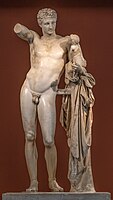
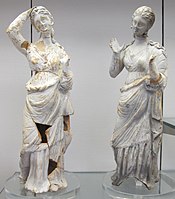
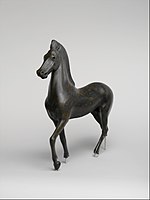
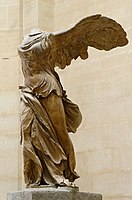


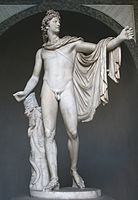

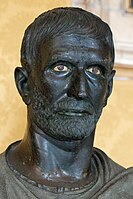







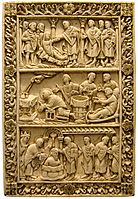

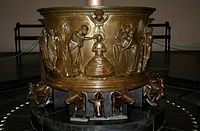
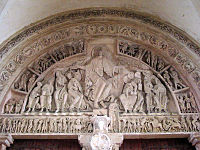





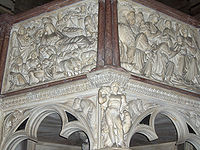

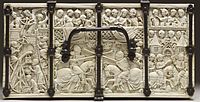

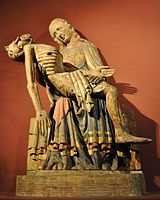









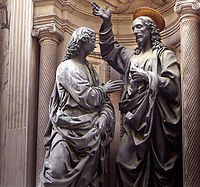
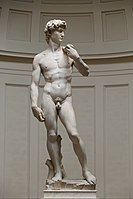

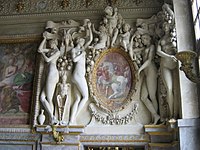

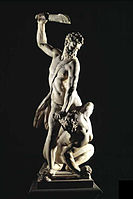
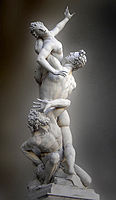





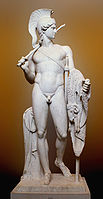
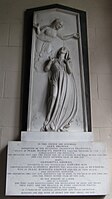










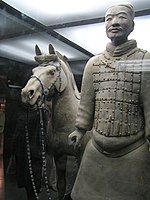
![Gold stag with eagle's head, and ten further heads in the antlers. An object inspired by the art of the Siberian Altai mountain, possibly Pazyryk, unearthed at the site of Nalinggaotu, Shenmu County, near Xi'an, China.[101] Possibly from the "Hun people who lived in the prairie in Northern China". Dated to the 4th-3rd century BCE,[101] or Han dynasty period.[102] Shaanxi History Museum.[102]](https://upload.wikimedia.org/wikipedia/commons/thumb/c/cb/Gold_monster.jpg/182px-Gold_monster.jpg)






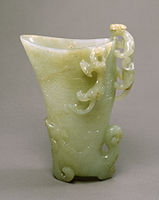


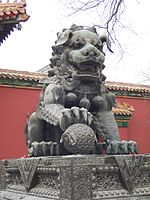
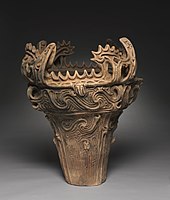
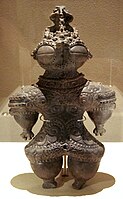


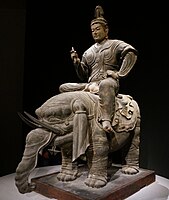


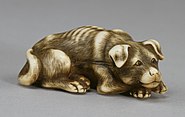

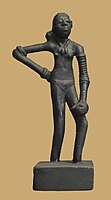


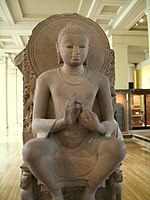


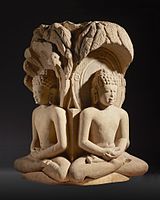



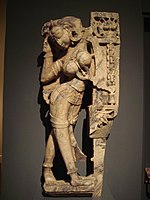
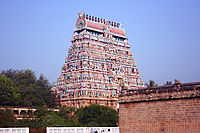
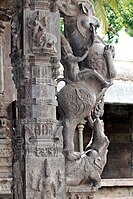







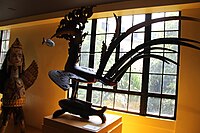
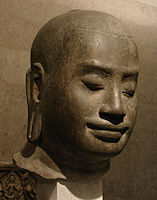
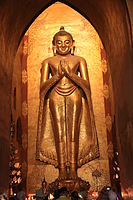


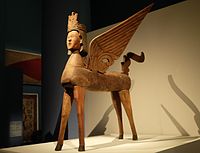
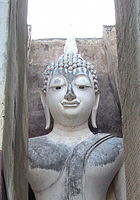
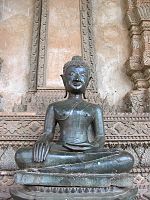

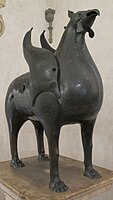
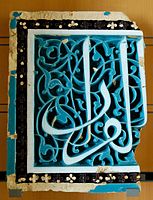

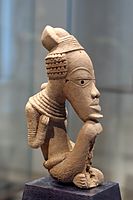
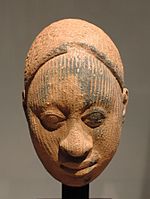


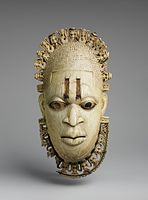



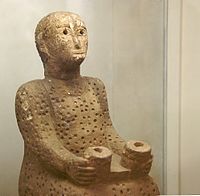



![One of the seven life-size saints carved into the wall of the Church of Bet Golgotha, Lalibela, 15th century (traditionally believed to have been made during the reign of Gebre Mesqel Lalibela)[123]](https://upload.wikimedia.org/wikipedia/commons/thumb/8/85/Bet_Golgotha.jpg/150px-Bet_Golgotha.jpg)


